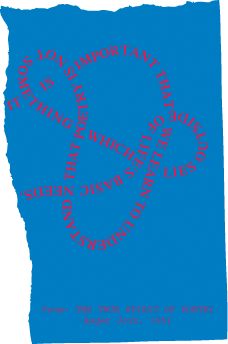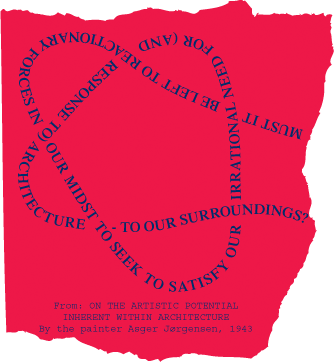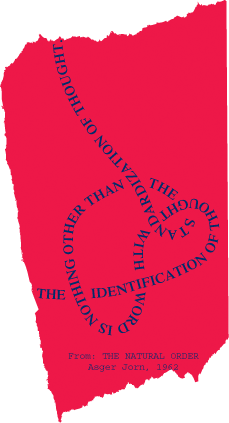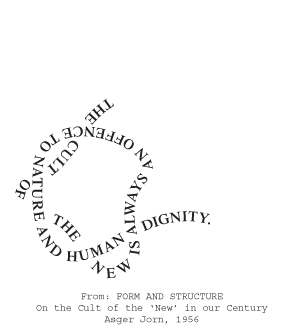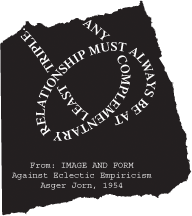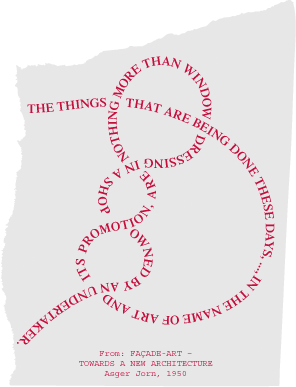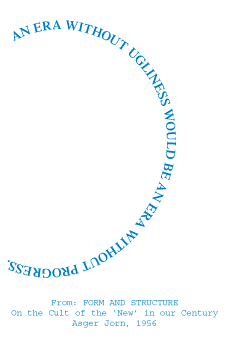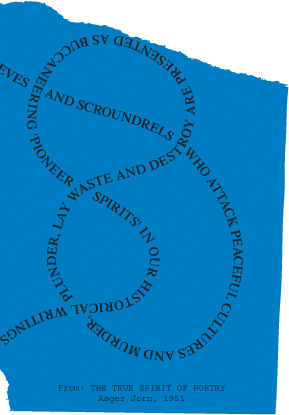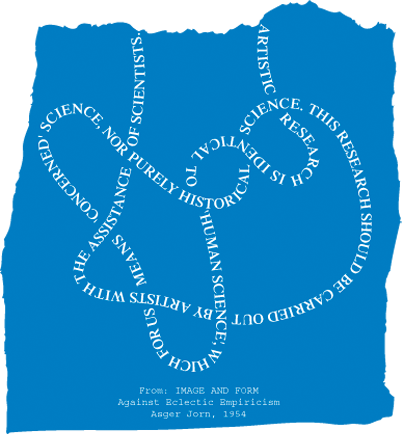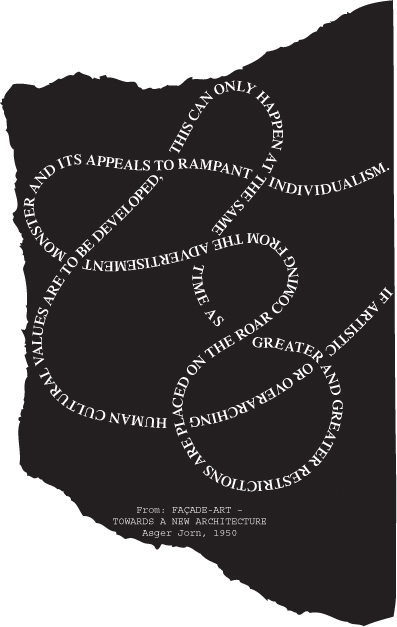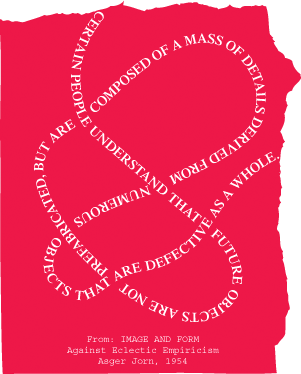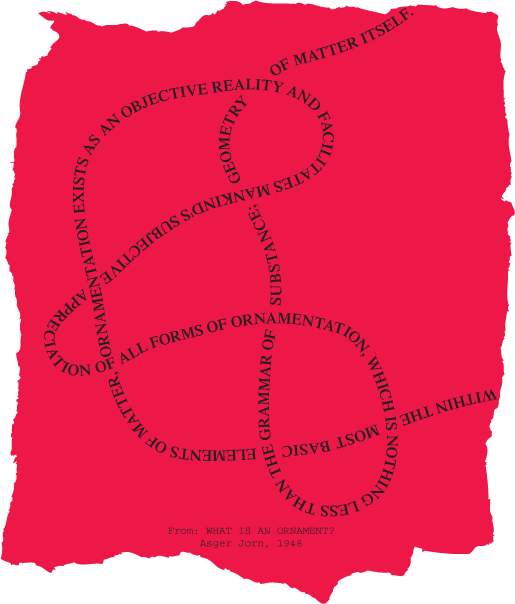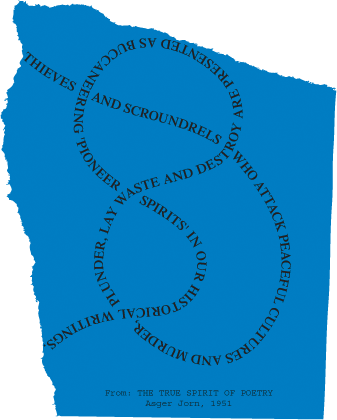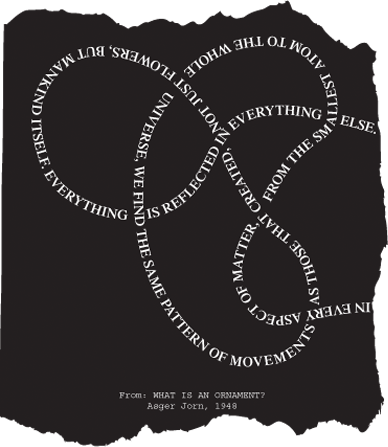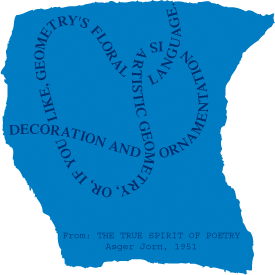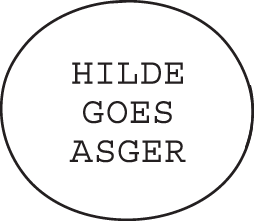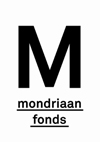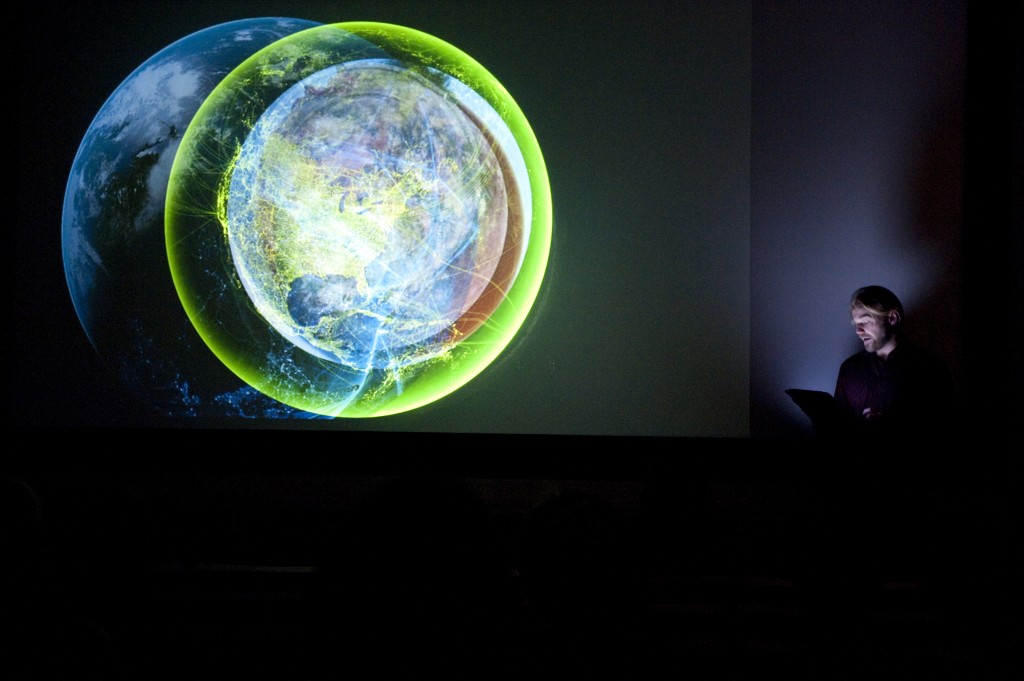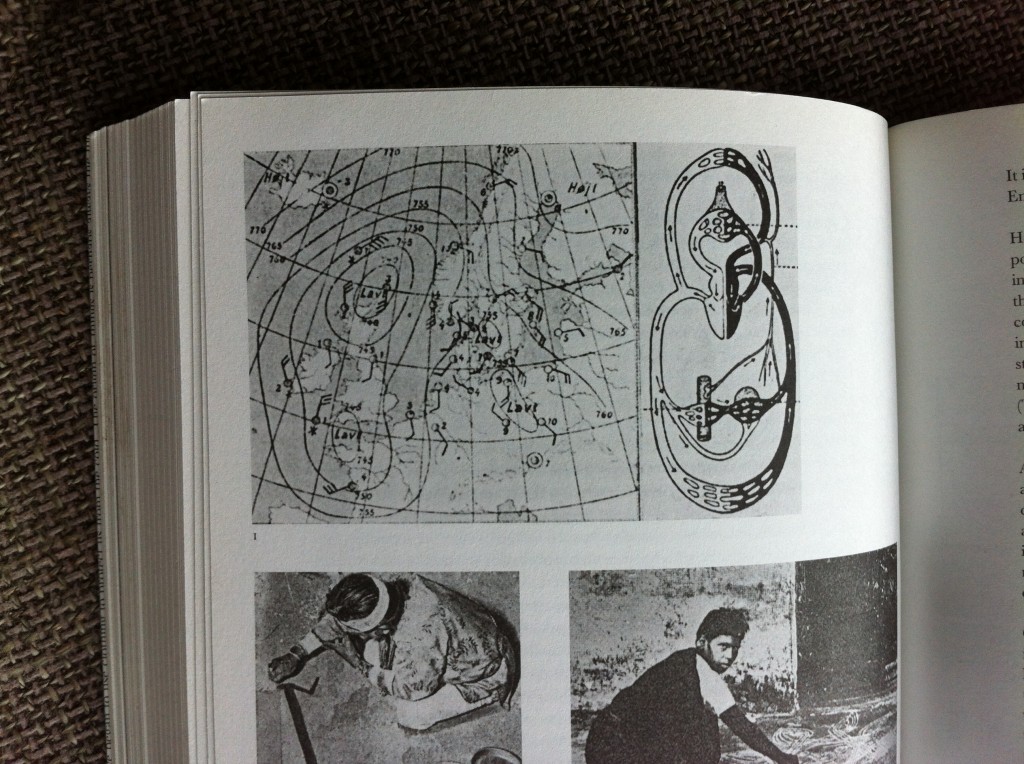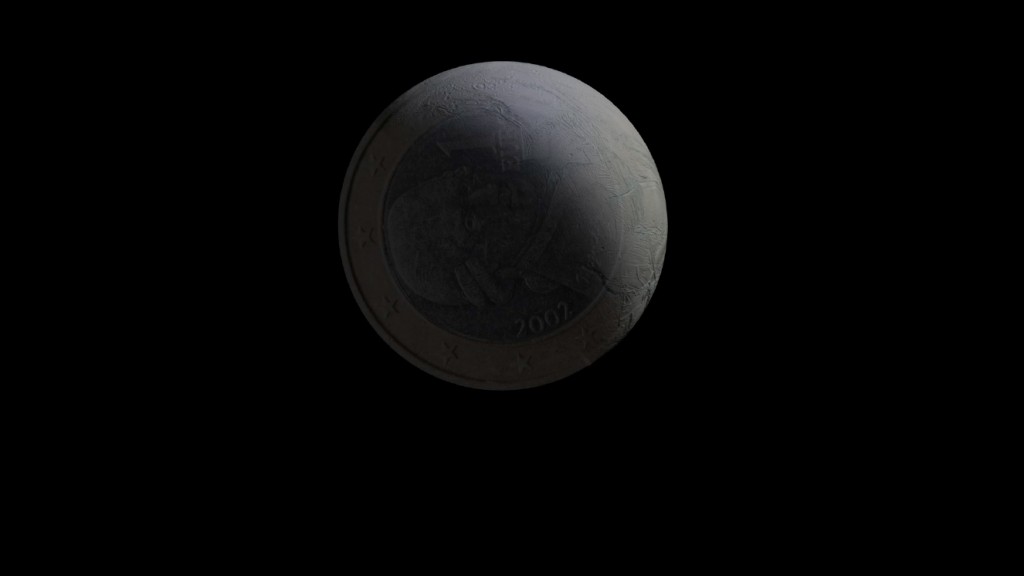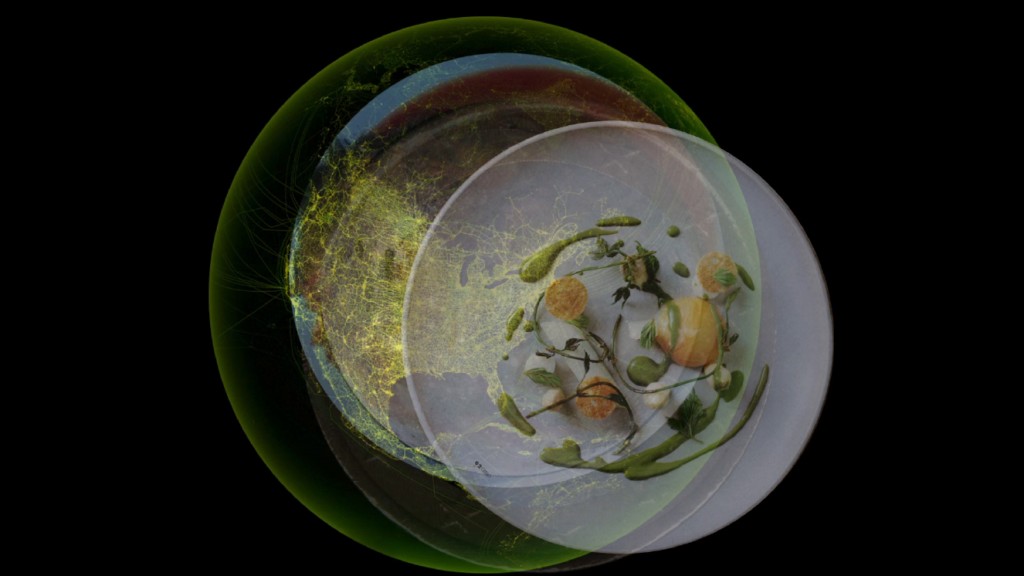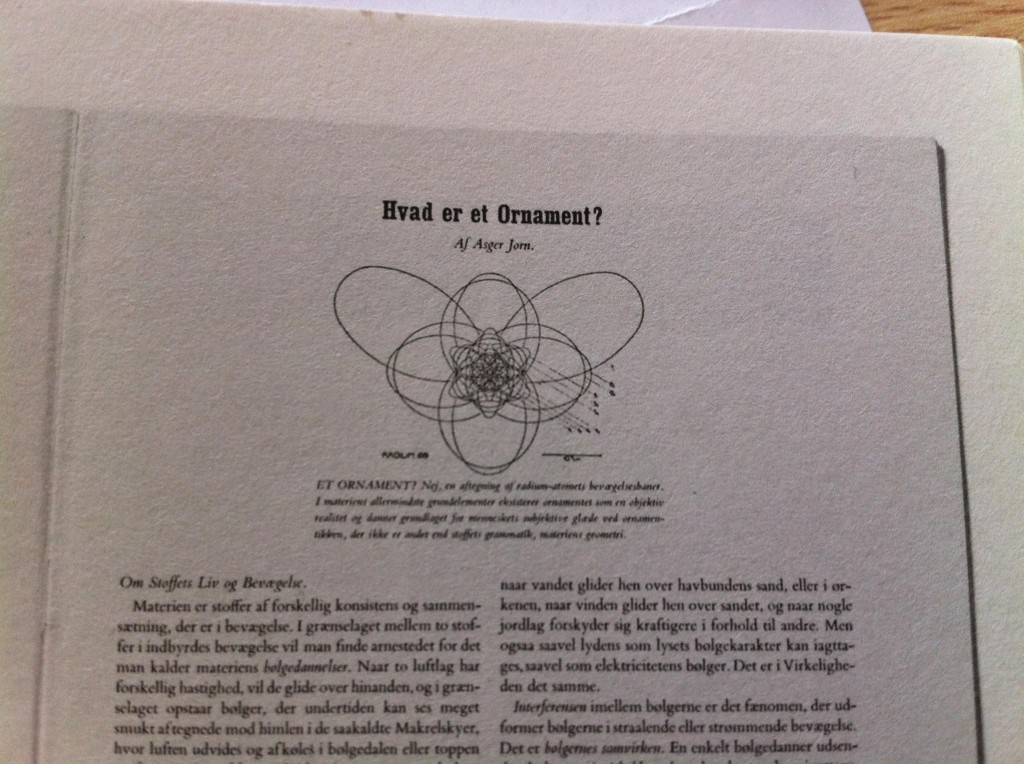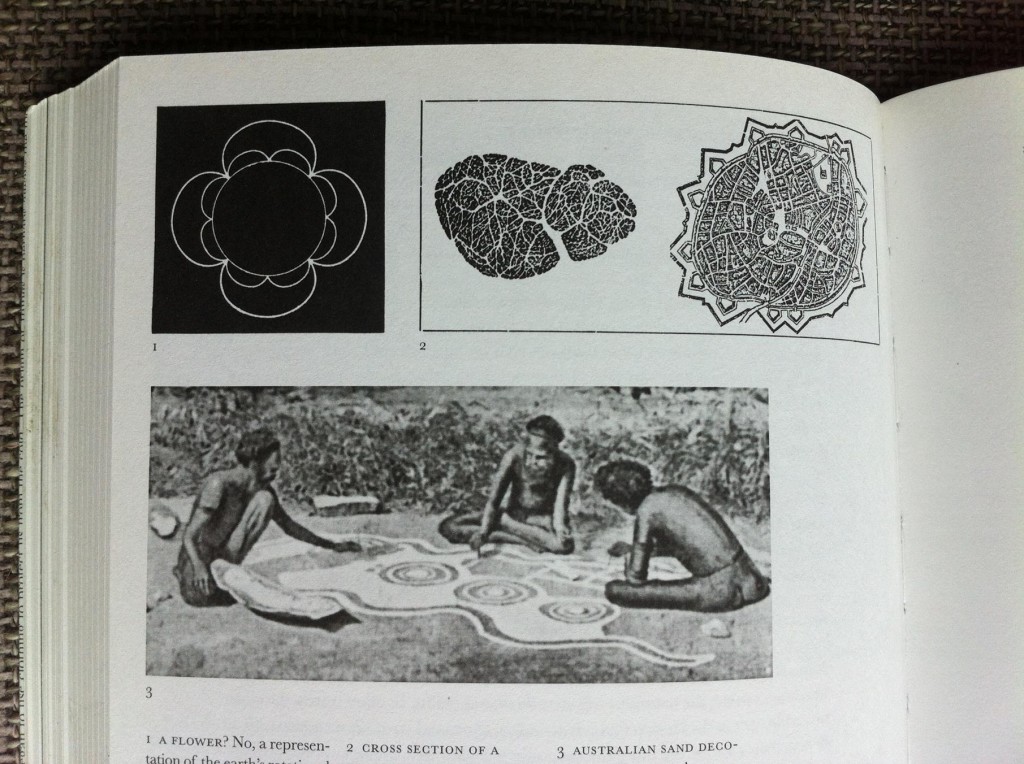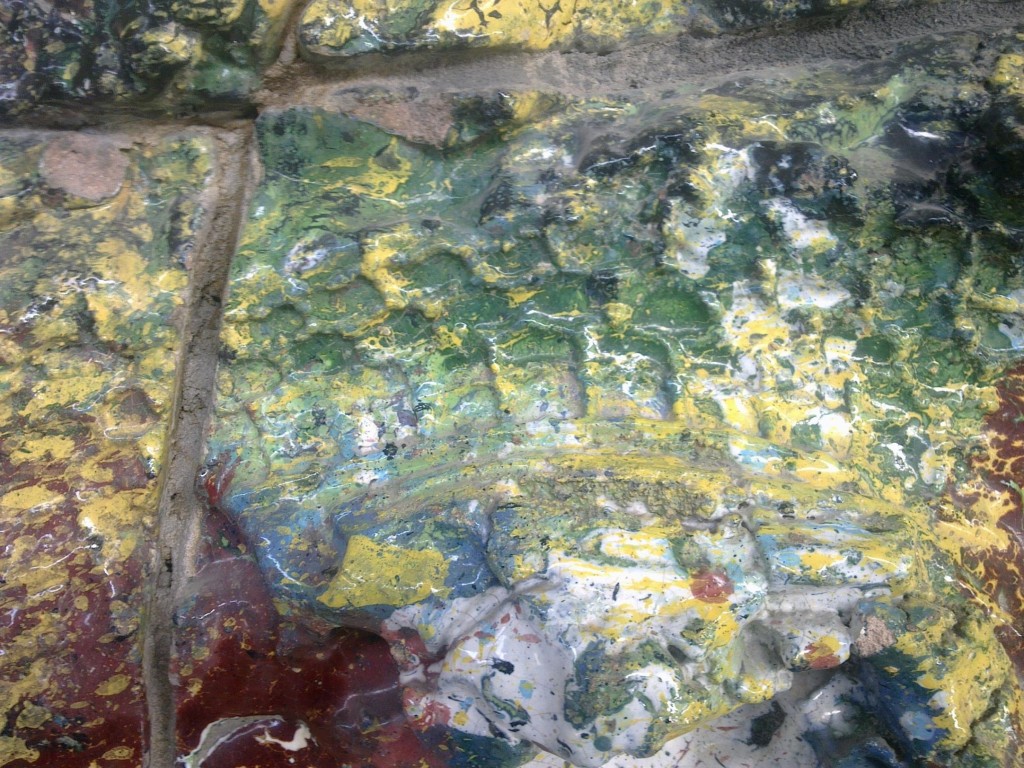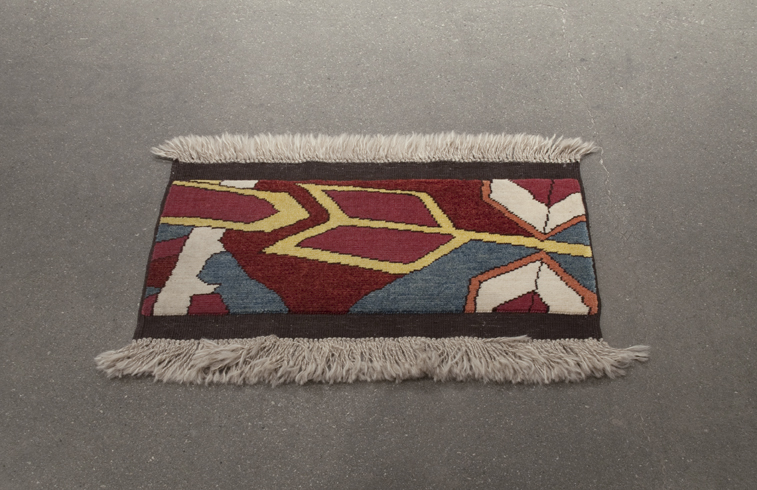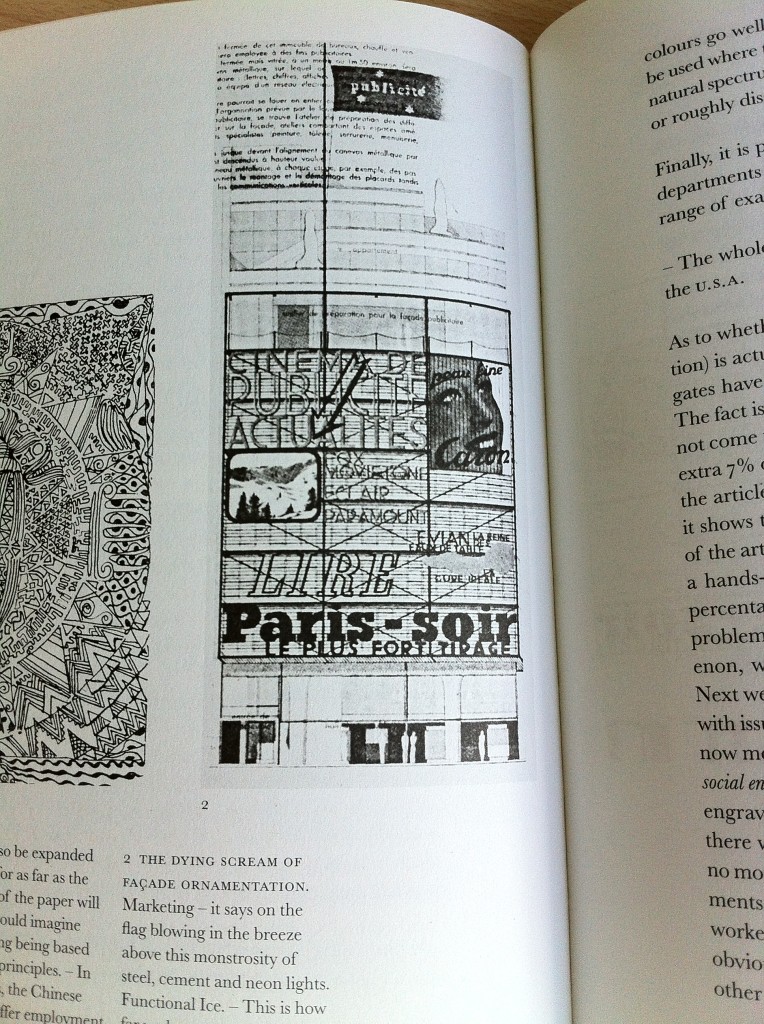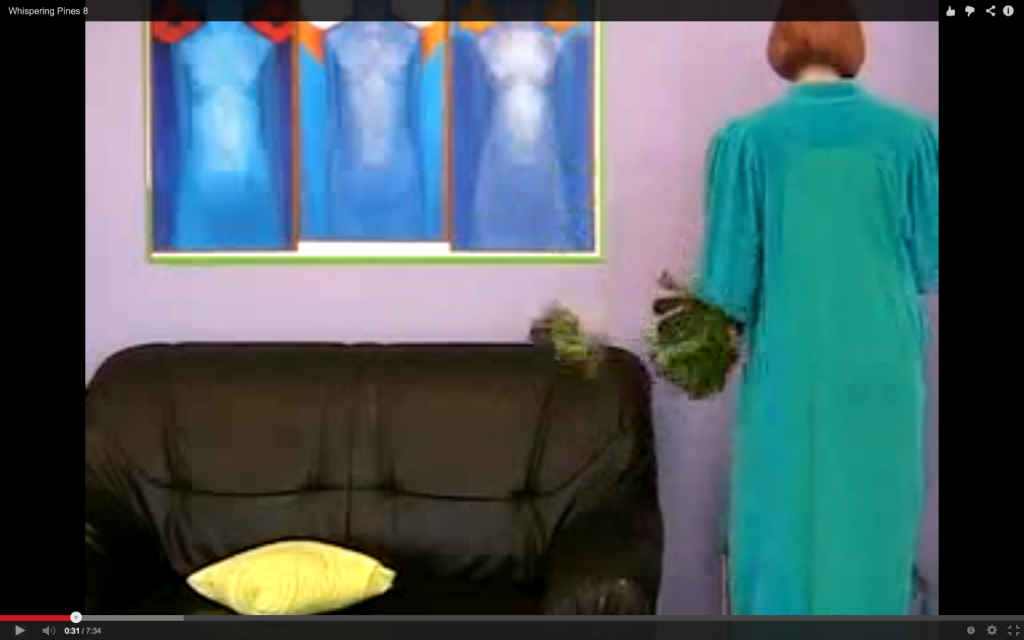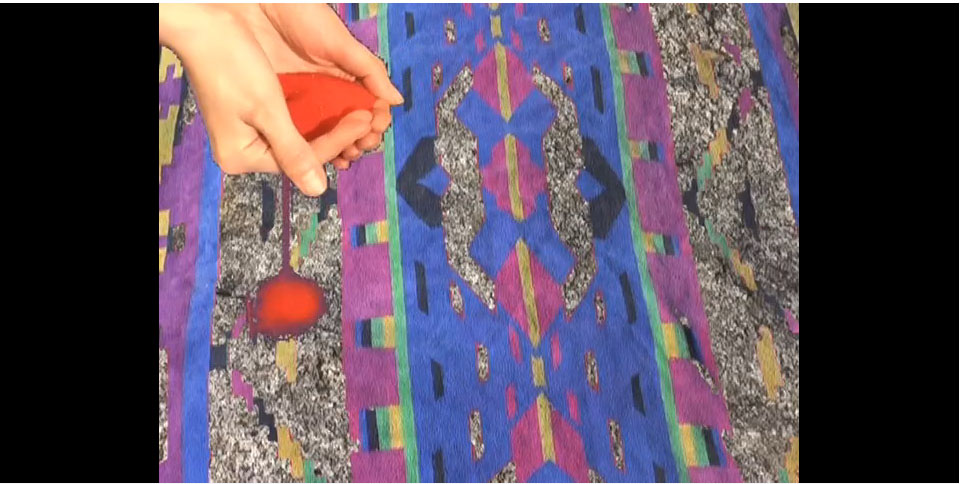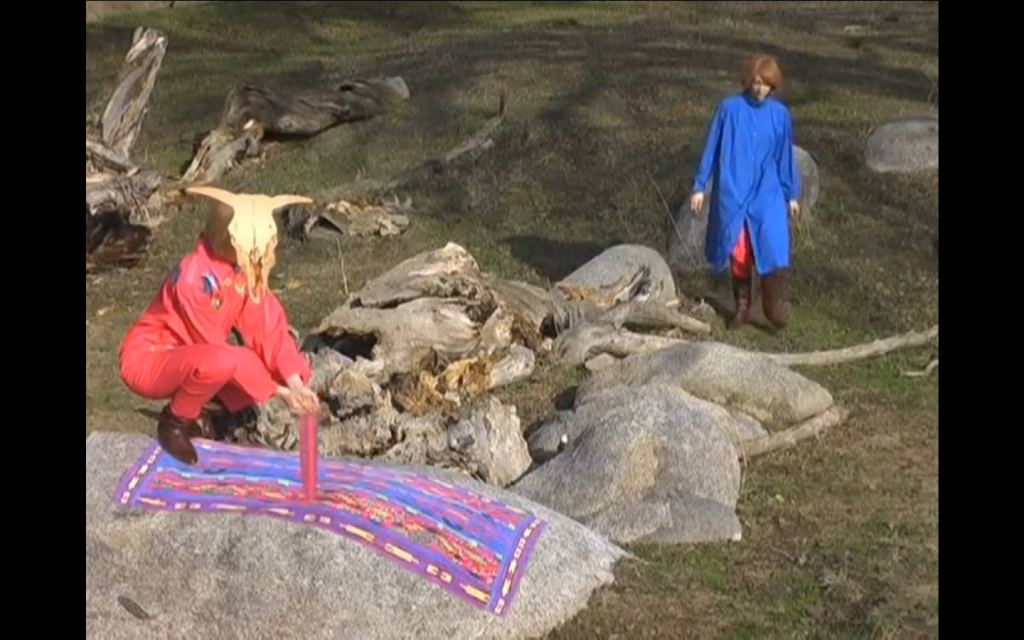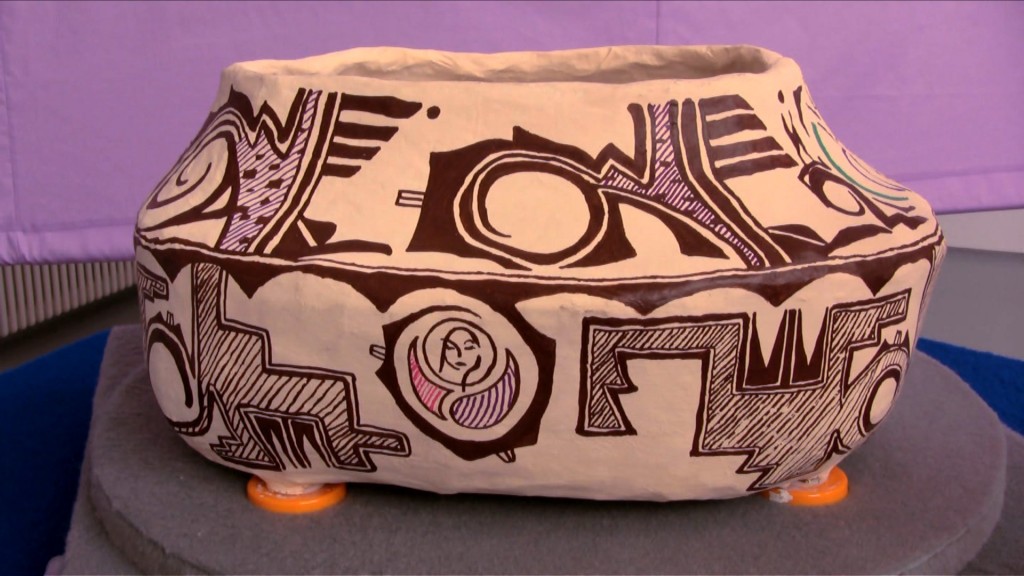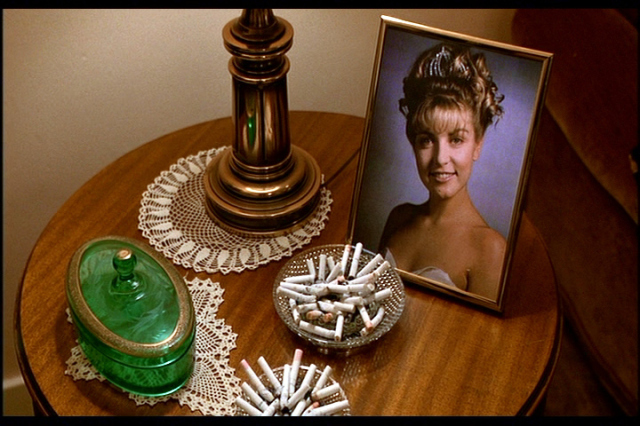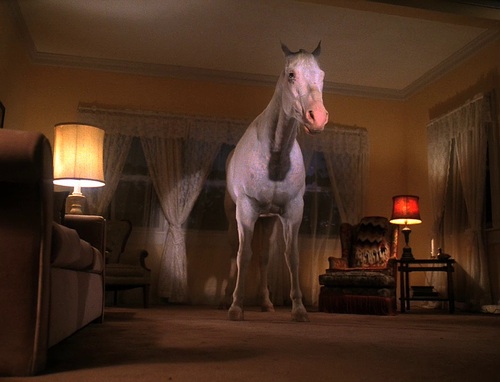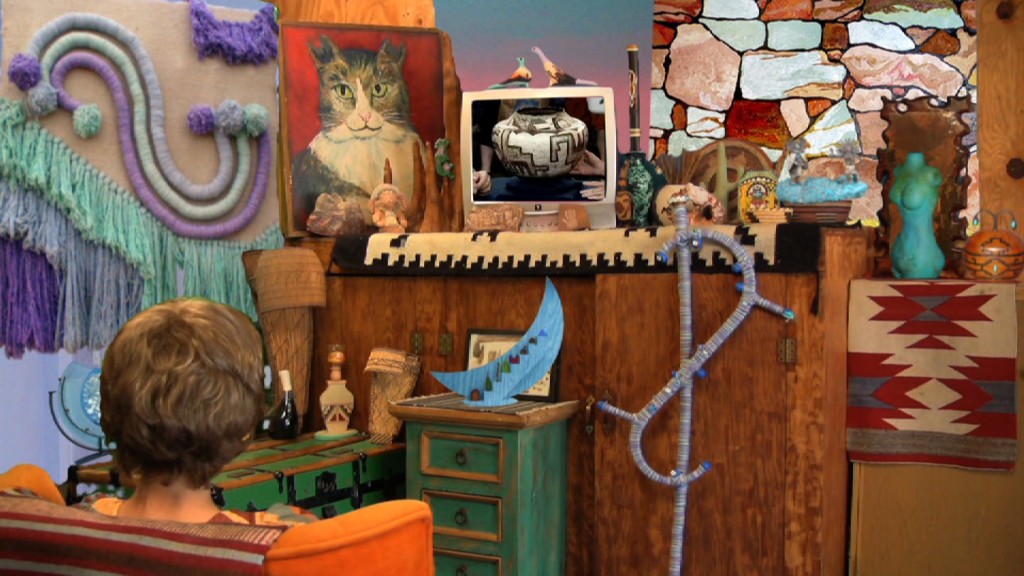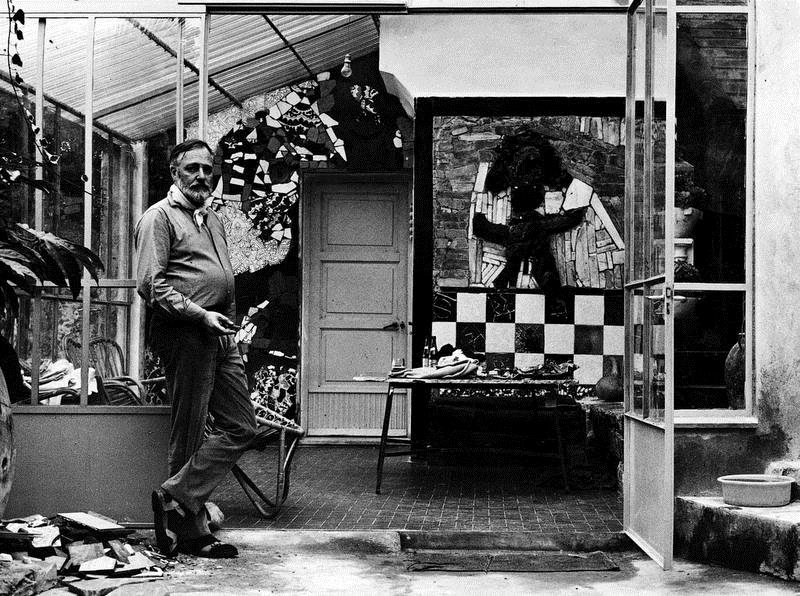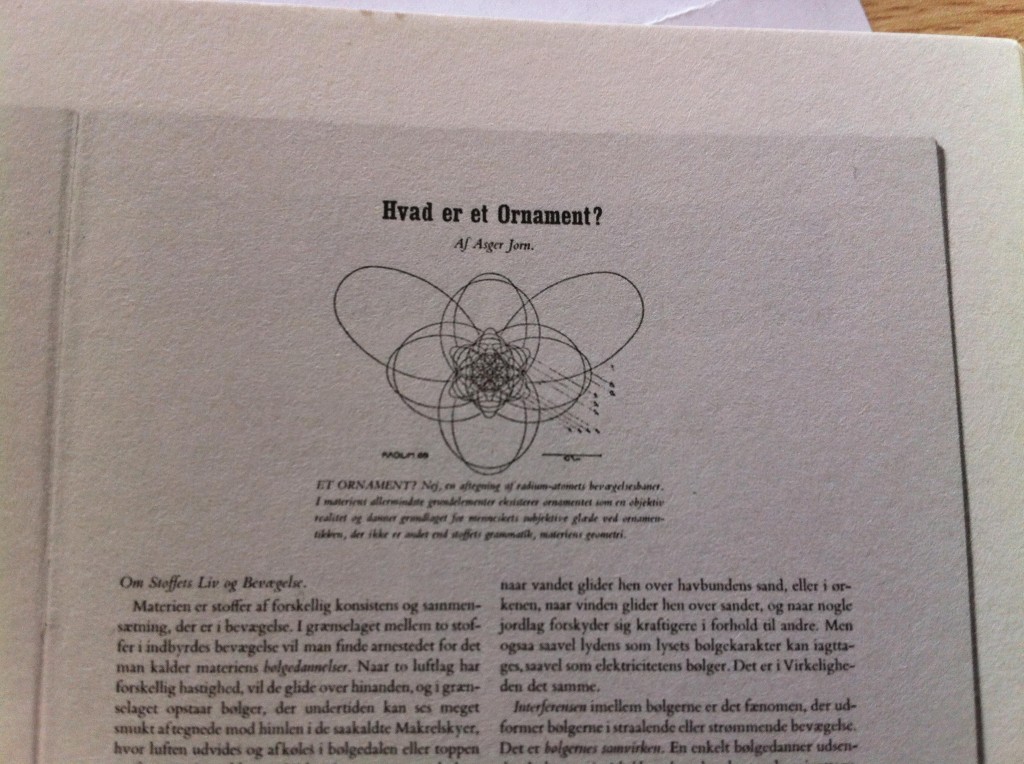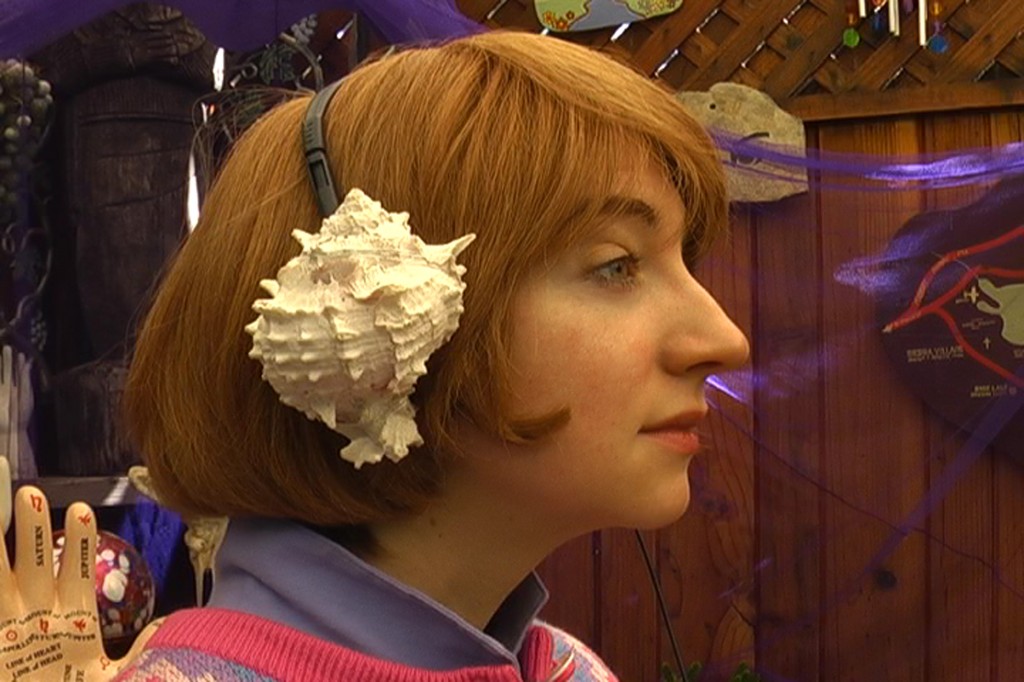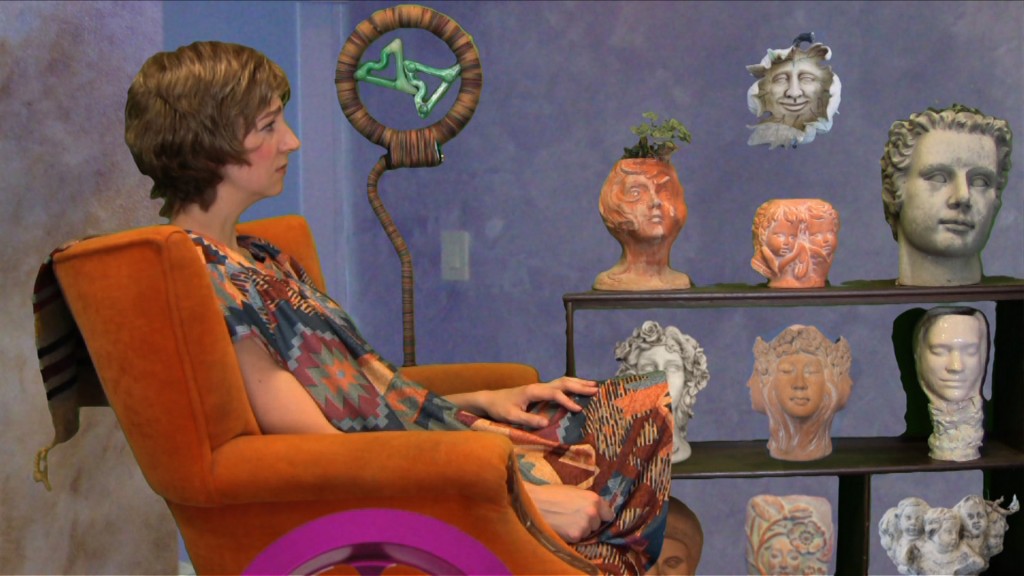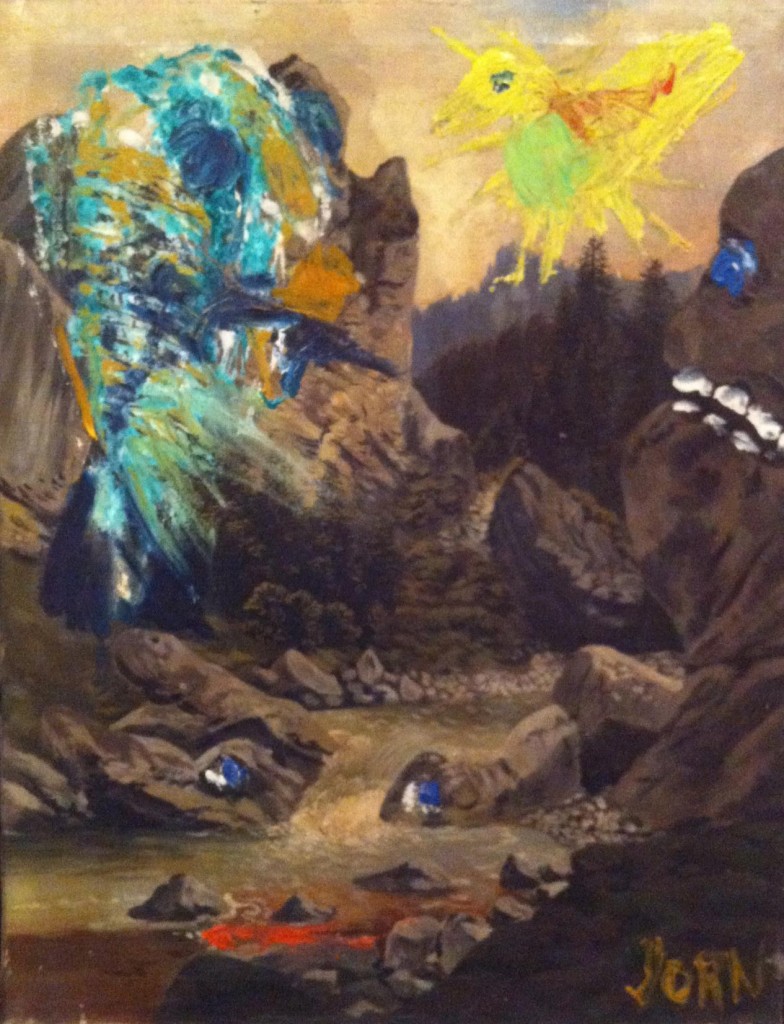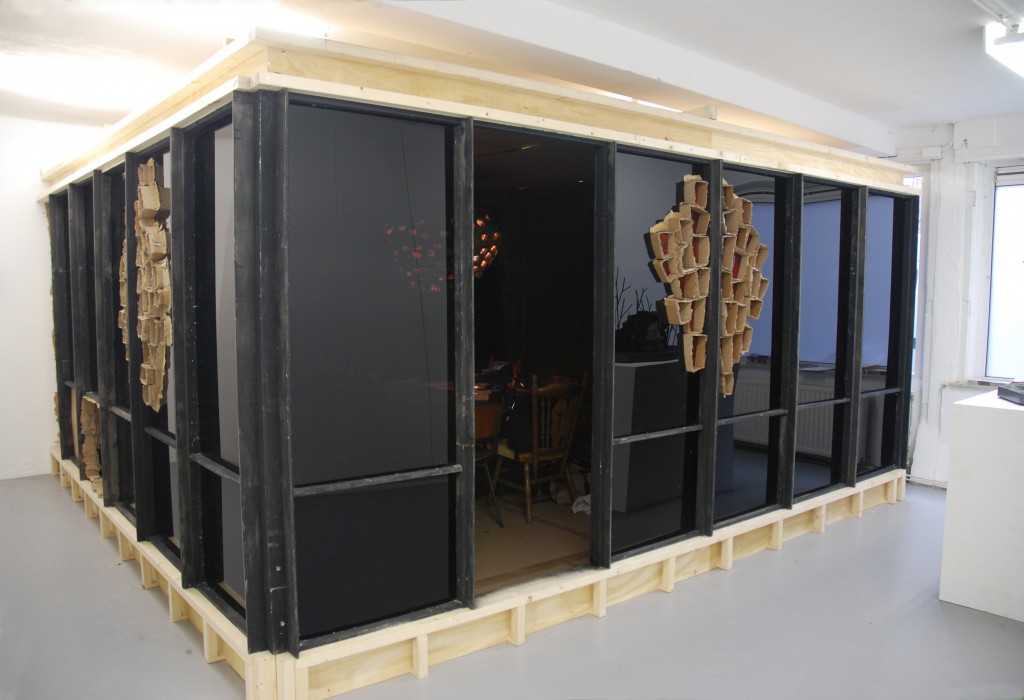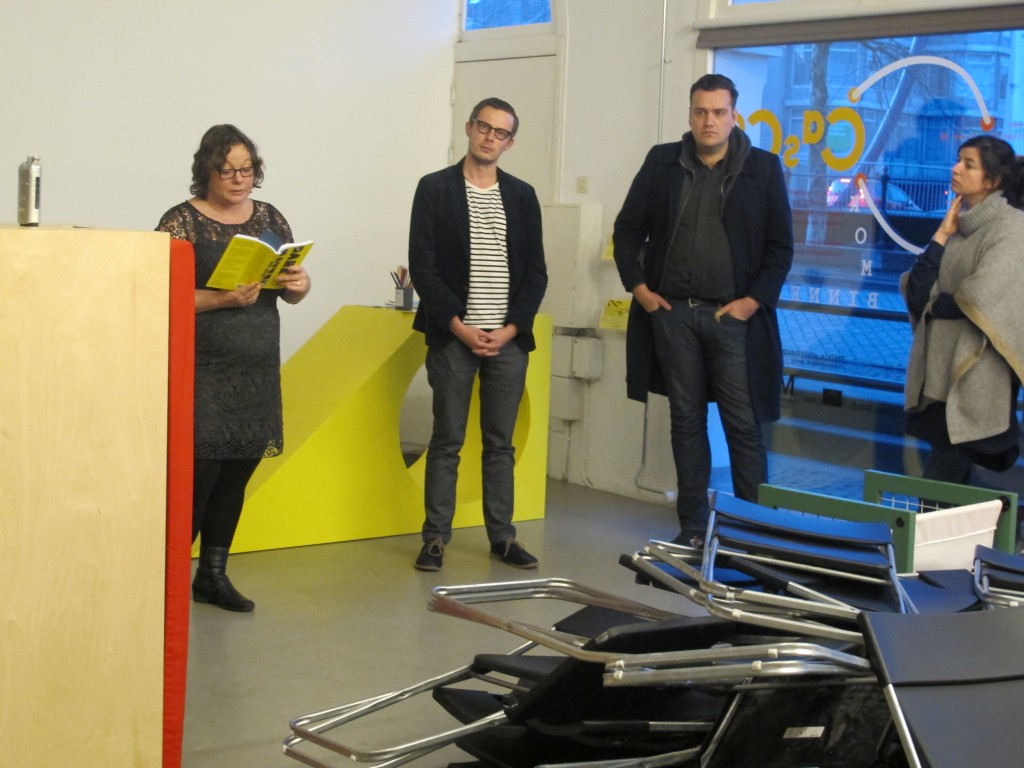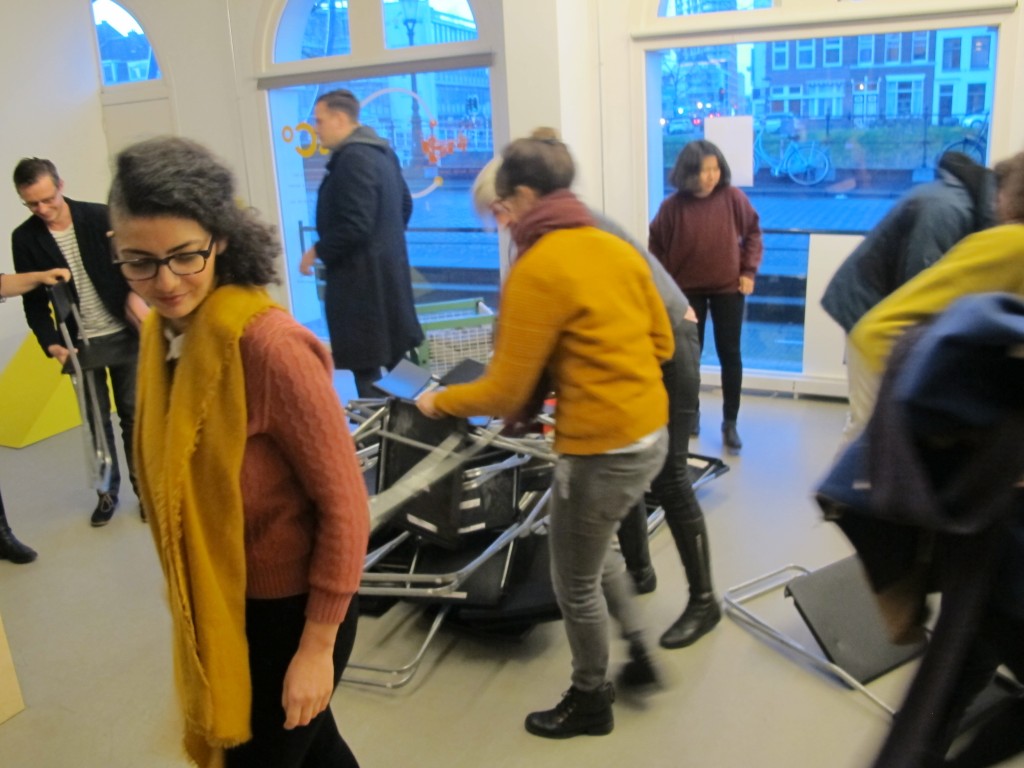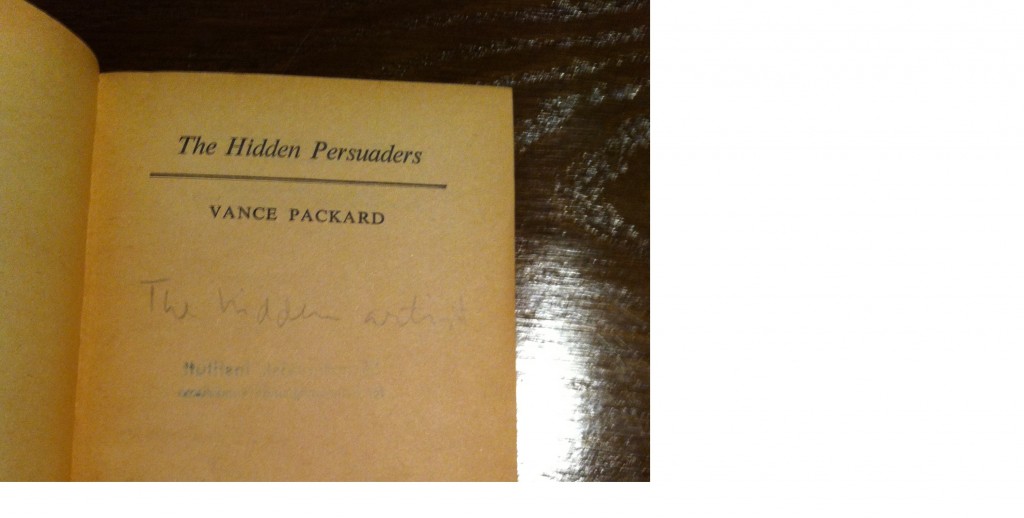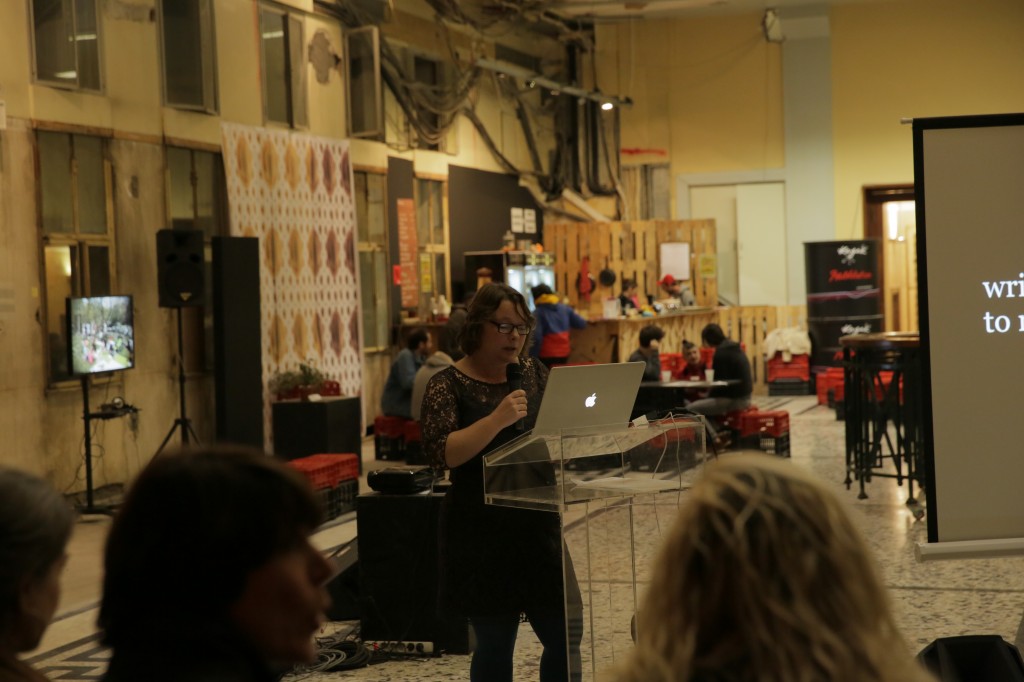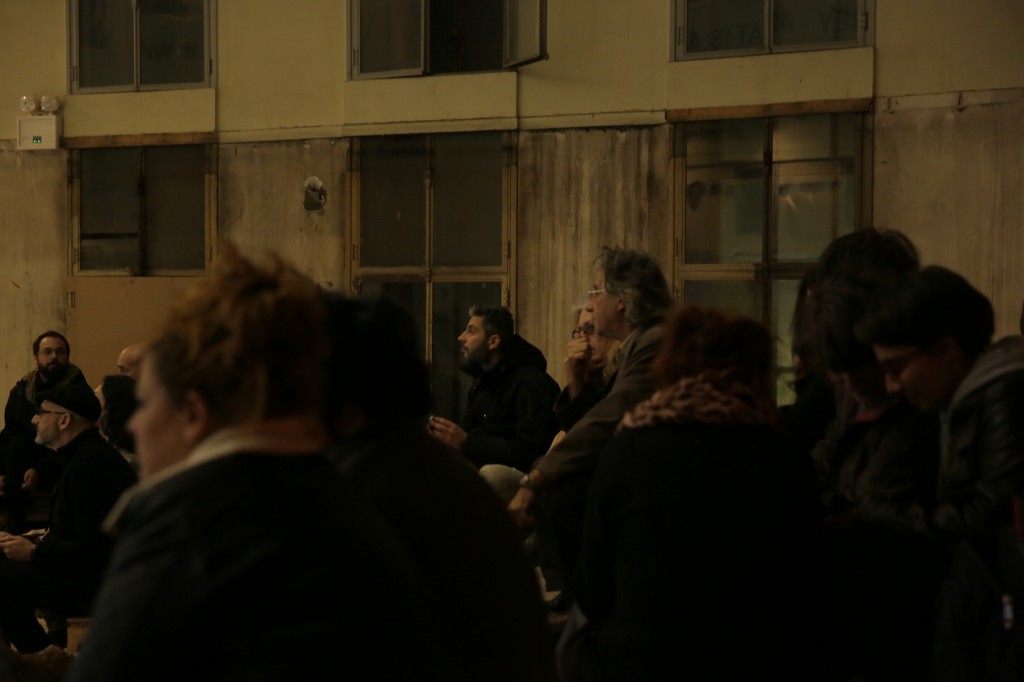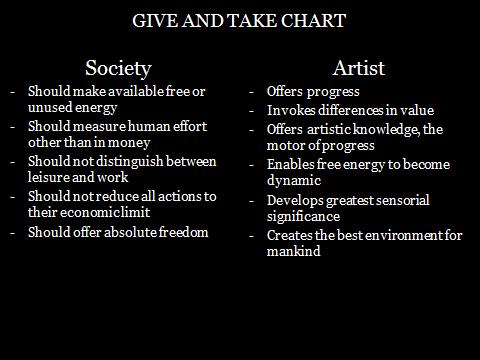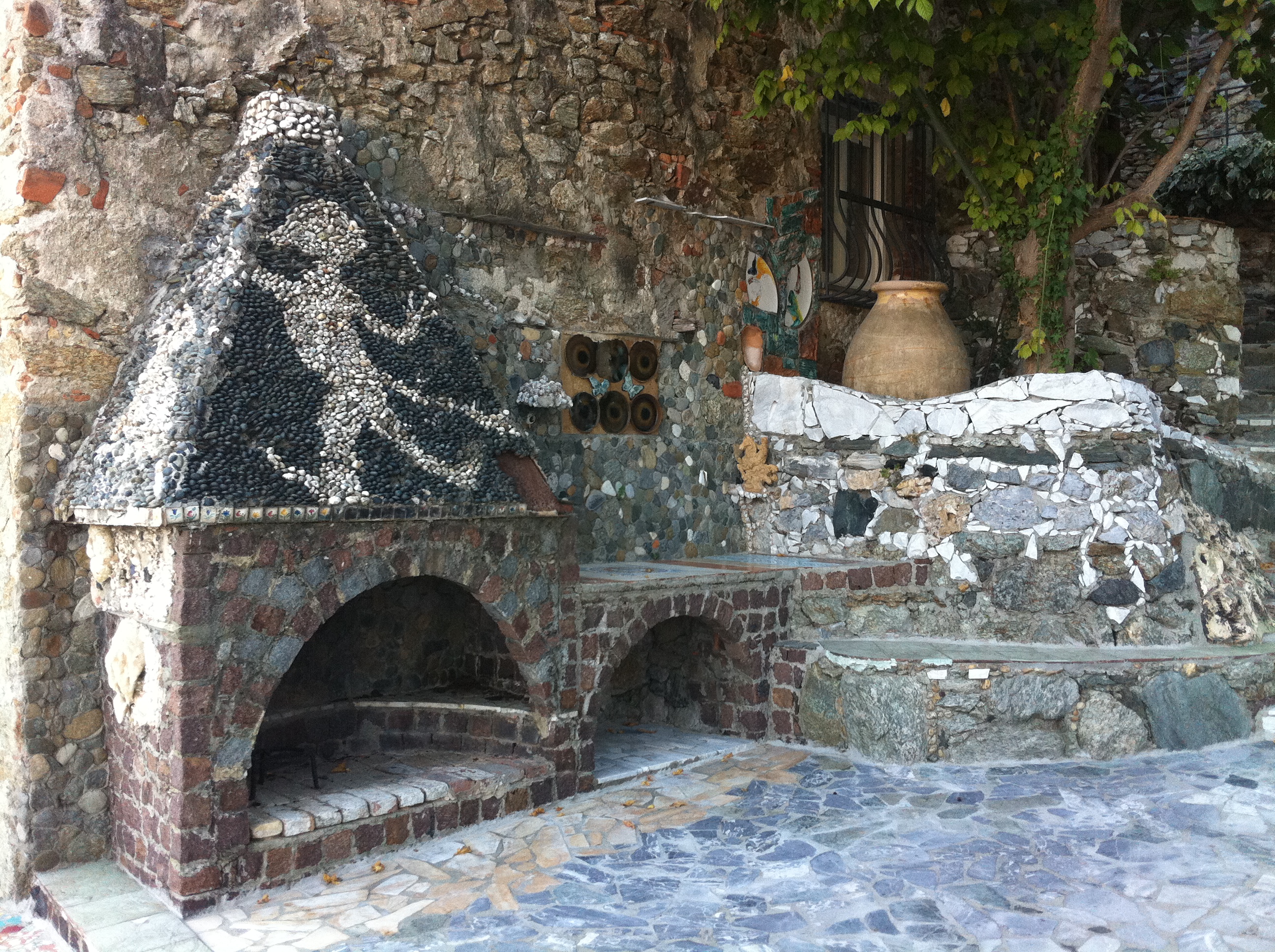THINKING THROUGH MATTER II
Within the framework of my research into Asger Jorn´s writing and thinking I organize public sessions with special guests at a variety of venues. The guest´s practice, knowledge, insights, or responses are informative to my research, or steer the direction I take on a particular topic. The sessions also often respond to the context of the hosting institution, or to a specific request. Making the sessions public is a way to share and enter into a dialogue with the audiences.
‘Thinking Through Matter’ was a talk by myself and Copenhagen-based artist Ferdinand Ahm Krag in the framework of the exhibition ’Asger Jorn – Restless Rebel’ at the Statens Museum for Kunst, Copenhagen. The talk took place Saturday 22 March 2014.
Both my introduction and Ferdinand Ahm Krag’s contribution find their starting point in Asger Jorn´s text ´What is an Ornament?’ from 1948. In this text Jorn states that ornamentation is to be found in all matter, that ornamentation is “the grammar of substance”, “the geometry of life” itself. Illustrations in Jorn’s text include a representation of the orbital paths of a radium atom, and a representation of the earth’s rotational curves within its phases of movement. They serve to stress his idea of the ornament as “spontaneous arabesque”, a type of ‘moving’ and hence dynamic ornamentation that is natural and about organic cohesion.
My text introduces these ideas (a different version though from the session ‘The Grammar of Substance’), and serves as a support to join in Ahm Krag’s thinking about what it means to be ‘natural’ and have a ‘natural’ relationship with materiality in our current times, the age of the anthropocene – the human-made geological epoch. You can find my introduction in the blog entry ‘Thinking Through Matter I’.
In his text ‘What is an ornament’ Asger Jorn describes the ornament as the formal language of nature. Different elements interact in such a way that it becomes ‘ornamental’: think of the patterns the wind and the clouds create. On a micro scale Jorn finds the principle of ornamentation inside the atom. But how far does the principle of ornamentation reach? When does it stop to relate to the human world? In relation to Jorn’s text I am particularly interested to try and locate the outer boundary of the ornament. How far does it stretch? So let us look at the figure of the ornament as a way of assembling a cosmology.
In his ambitious trilogy ‘Spheres’ the philosopher Peter Sloterdijk tries to describe a metaphysical history of “enclosed spaces, utopian or practical pods and domes, real and fantastical atmospheres of ecosystems”. In the first volume he writes: “since the start of the Modern Age, the human world has constantly – every century, every decade, every year and every day – had to learn to accept and integrate new truths about an outside not related to humans.” And he continues: “Every view into the extra-terrestrial spaces provided increasing evidence that mankind is towered above on all sides by monstrous externalities that breathe on it with stellar coldness and extra-human complexity. The old nature of homo sapiens is not up to these provocations by the outside.”
Matter builds up into solar systems that build up into galaxies that build up into clusters and superclusters, and at the very largest scale we find the filament-structures of visible and dark matter – the overall superstructure of the known cosmos. The ornament of matter at the largest scale. Does the natural ornament of matter at a certain point leave the human being behind – and where exactly is this point? And where should we position Asger Jorn in all this? Does he stay within a human centered world?
One could wonder why there are no images of spiral galaxies in Asger Jorn’s text ‘What is an ornament?’ Asger Jorn never leaves planet Earth. It’s from the ground that he looks up and observes the patterns of the clouds and the weather. Today the weather has become climate and the topic of climate change. Climate models always envision the globe seen from outer space. From some thousand kilometers above ground, where there is no gravity. Climate models place us in an imaginary space outside earth and this positioning of ourselves outside earth trying to monitor the climate is made possible by the interior workings of computers. Asger Jorn stays on ground – he stays grounded. But he inhabits the ground in such a way that it seems to be infinite in all directions.
For those of you who have seen the movie ‘Gravity’ – that just won seven Oscars – you will know that the film starts with the following statement: LIFE IN SPACE IS IMPOSSIBLE. ‘Gravity’ is about an astronaut – Dr. Ryan Stone – trying to fight her way out of space and back down to earth. It’s a sort of reversed science-fiction: It’s not about expansion out into Space. It’s about getting back down to earth. Getting grounded and gaining gravity.
It is called ‘re-entry’ when a space-shuttle comes down the atmosphere from outer space. If the film ‘Gravity’ reflects the changing mental state of a culture that now is in the process of a re-entry – a re-entry to the planet and the materiality that makes up the planet, then the question is: what ground are we re-entering? Is it the same ground consisting of the same materiality as when we – metaphorically speaking – took off from the ground in the beginning of modernity ?
If we follow the logic of the film ‘Gravity’ the odd thing is, that it is Earth itself that has become utopia. Not Space. But if it is Earth itself that is the new ´space´ to project our ideals onto, then one might ask: if we are not on earth, then where are we? Apparently we are dealing with this problem of locating where we are?
Marx wrote the following famous words in the communist manifesto: “All fixed, fast-frozen relations, with their train of ancient and venerable prejudices and opinions, are swept away, all new-formed ones become antiquated before they can ossify. All that is solid melts into air.” We are now learning that the ‘air’ Marx mentions is not at all a metaphor. This ‘melting process’ of industrialization and of capitalism has been so profound that it has within the last century led to an epoch-scale crossing of a geological boundary.
If we took off from the planet in the beginning of Modernity we are now in the process of a very troubling and difficult re-entry that brings us beyond modernization. We took off in the geological period called the Holocene – the geological period of time that for 10.000 years provided a safe environmental envelope within which contemporary civilization has developed. Our re-entry to the planet – this re-orientation towards matter, this re-materialization of human thought – is not a re-entry to earth and matter as we know it. It’s an entry to a radically new world. Some geologists have now come up with the term the Anthropocene’. The thesis of ‘the Anthropocene’ suggest that:
“The earth is now moving out of its current geological epoch, called the Holocene and (ii) that human activity is largely responsible for this exit from the Holocene, that is, that humankind has become a global geological force in its own right” – (The anthropocene: conceptual and historical perspectives – Will Steffen, Jacques Grinevald, Paul Crutzen and John McNeill, The Royal Society, 2011)
The starting point of the Anthropocene is set in 1950 by geologists. Jorns text ‘What is an Ornament’ is from 1948 – an interesting coincidence. I would like to bring up one of his interpretations of the ornament again: “The ornament as spontaneous arabesque, which manifests itself as a set of elements within a greater whole. This is ‘moving’ and hence dynamic ornamentation. It is about organic cohesion”.It is my strong feeling that Asger Jorn´s thoughts on the ornament and ornamentation – in some updated version – could be a powerful and necessary contribution to the urgent task of assembling an ecological thought that is not grounded in the Holocene, but instead in the strangely disrupted world of the Anthropocene that goes beyond all former notions of the natural world.
I will now show a video that I recently made and which is partly inspired by Jorns thinking about the ornament. But it also differs a lot from his thinking. My work does not really deal with `organic cohesion`. Instead it is about “digital cohesion”. It is a kind of spontaneous digital primitivism. And the question is – for later discussion – if there still is such a thing as “organic cohesion” that can be used as a model for a materialistic cosmology? How do “organic cohesion” and “digital cohesion” relate to one another?
Ferdinand Ahm Krag, 2014
THINKING THROUGH MATTER (I)
Within the framework of my research into Asger Jorn´s writing and thinking I organize public sessions with special guests at a variety of venues. The guest´s practice, knowledge, insights, or responses are informative to my research, or steer the direction I take on a particular topic. The sessions also often respond to the context of the hosting institution, or to a specific request. Making the sessions public is a way to share and enter into a dialogue with the audiences.
‘Thinking Through Matter’ was a talk by myself and Copenhagen-based artist Ferdinand Ahm Krag in the framework of the exhibition ‘Asger Jorn – Restless Rebel’ at the Statens Museum for Kunst, Copenhagen. The talk took place Saturday 22 March 2014.
Both my introduction and Ferdinand Ahm Krag’s contribution find their starting point in Asger Jorn´s text ´What is an Ornament?’ from 1948. In this text Jorn states that ornamentation is to be found in all matter, that ornamentation is “the grammar of substance”, “the geometry of life” itself. Illustrations in Jorn’s text include a representation of the orbital paths of a radium atom, and a representation of the earth’s rotational curves within its phases of movement. They serve to stress his idea of the ornament as “spontaneous arabesque”, a type of ‘moving’ and hence dynamic ornamentation that is natural and about organic cohesion.
My text introduces these ideas (a different version though from the session ‘The Grammar of Substance’), and serves as a support to join in Ahm Krag’s thinking about what it means to be ‘natural’ and have a ‘natural’ relationship with materiality in our current times, the age of the anthropocene – the human-made geological epoch. You can find Ahm Krag’s talk in the blog entry ‘Thinking Through Matter II’.
What is an Ornament?
Jorn wrote the article ‘What is an ornament?’ in 1948. The text was up to a large extend stemming from Jorn’s critique on the predominant functionalist architecture of the time. Functionalist architecture, roughly said, means that the design of a building should clearly reflect its purpose. In the area of ornamentation this also generally implied that features which are not necessary for convenience, construction, or propriety, were not desirable.
The famous article ‘Ornament and Crime’ by architect Austrian Adolf Loos from around 1910 has been highly influential in the thinking about ornamentation and functionality. Loos regarded ornamentation as the expression of repressed human drives from the subconscious, and believed that we have to transcend these, in order to culturally progress. Asger Jorn, on the contrary, claimed that ornamentation is a fundamental need of human beings, and that a truly functionalist architecture would acknowledge and address this need. As early as 1943 he wrote: “Must it be left to the reactionary forces in our midst to seek to satisfy our irrational need for (and response to) architecture – to our surroundings?” From: ‘On the artistic potential inherent within architecture’ (By the painter Asger Jørgensen)
One of the aspects that Jorn discusses in ‘What is an ornament?’ is what he calls “the tragic history of the ornament in art” – the fact that in the western world, art itself became split into two categories: high art (also classical art) and low art, which Jorn refers to as “folk/banal or spontaneous art”. In relation to this, he states that there are two different interpretations of the ornament:
- The ornament as monumental decoration which seeks to form a finite whole, and becomes static ornamentation.
- The ornament as spontaneous arabesque, which manifests itself as a set of elements within a greater whole. This is ‘moving’ and hence dynamic ornamentation. It is about organic cohesion.
Examples of static ornamentation are: classicist Renaissance art, and various forms of neo classicism.

Book cover, 'Bauerliche Barock Prediger', from Jorn's personal library, now at Museum Jorn, Silkeborg
Dynamic ornamentation is to be found in the art forms of all primitive people, art of the Orient, and prehistoric art – until Romanesque monumentalism set in. From that moment on says Jorn, there has been a constant reappearance and disappearance of dynamic ornamentation: Baroque, Rococo, Empire Style, Art Nouveau.
Jorn connects the appearance and re-appearance of both static and dynamic ornamentation to economic and political changes – static ornamentation belonging to classical art, the language of the ruling class, and dynamic ornamentation belonging to spontaneous art, belonging to the people. He also notes that static forms have a tendency to become dynamic because dynamic art “is the natural way of things”.
Ornamentation as the formal language of nature itself
There is however much more to be discovered about Jorn’s text than categorization of ornamentation, or the defence of ornamentation in a critique of functionalism. In fact, the very first point that Jorn makes in ‘What is an ornament?’, is that “Matter consists of substances in motion that have different composition values and consistencies. At the interface between two substances engaged in mutual motion, we find the catalyst for that which we describe as the wave formation of matter.” Think of wind-clouds, wind-sand, sound-light etc. He importantly adds that “this cohesion that exists within the reaction forms inherent in different substances, includes that of mankind.” Jorn illustrates the idea with several images.
The first one he provides with a long caption saying: “An ornament? No, a drawing of the orbital paths of a radium atom. Within the most basic elements of matter, ornamentation exists as an objective reality and facilitates mankind’s subjective appreciation of all forms of ornamentation, which is nothing less than the grammar of substance; the geometry of life itself.”
Jorn’s caption with the first image is: “A Flower? No, a representation of the earth’s rotational curves within its phases of movement. In every aspect of matter from the smallest atom to the whole universe, we find the same pattern of movements as those created, not just flowers but mankind itself. Everything is reflected within everything else.
The second image shows a cross section of the human muscle with right next to it, a map of a town in the Middle Ages. The third images says ‘Australian sand decoration’.
Another article (‘Levende Cultuur’ / ‘Living Culture’) by Jorn, which art historian Graham Birtwistle brings up in his publication ‘Living Art’, starts out in a similar way. Just like in ‘What is an Ornament?’ which was written only a year before, Jorn discusses the arabesque, defining the arabesque as “the expression of movement on all levels”. To Jorn, the arabesque (ornamentation) is the formal language of matter itself. This notion of the arabesque is part of Jorn’s argument for the unity of all life. He says: “All that we know of life is that it is organized movement. All that exists and lives is in movement and forms arabesques in time and space. These arabesques are completely in themselves and yet at the same time they become involved with other arabesques and thereby form organisms; these, in turn, are part of still larger movements which are taken up in that universal movement which we call matter.”
Jorn’s theory of materiality
The fact that Jorn in both ‘What is an Ornament’ and in ‘Living Culture’ starts out defining the ornament as “the grammar of substance, the geometry of life itself”, is indicative for how much the examination and negotiation of the relation between the materiality of the art work and its discursive meanings, between matter and mind in general, meant to him. These issues were of crucial importance in Jorn’s practice. I will discuss his materialist(ic) attitude to life, and would first like to mention art historians Helle Brons and Graham Birtwistle, as their writings which have been very informative to this.
Jorn’s theory of materiality is inspired by thinkers such as Karl Marx, Susanne Langer, Gaston Bachelard, and Niels Bohr – all of whom emphasized – in different ways – the role of physical matter in human thinking. Despite the fact that Jorn was also very critical of some of their ideas, they built an important basis for his own thinking, or re-thinking of matter. This includes thinking about art not as something derived from an ideology or world-view (as Marxist art theory and aesthetics often suppose) but thinking of art as the direct expression of an attitude to life, and as belonging to the fundamental level of work and production. At the basis of his thinking is also the relationship between the visual, the material and the semantic (On an artistic level this means that Jorn’s aim was not a purely visual or material art, but “a recognition of these aspects as meaningful in itself before the discursive level”, as Helle Brons puts it in her paper ‘Material Meanings’), and not in the last place it also includes the thinking of the agency of material matter, the idea that the material world cannot be seen as passive, pre-shaped objects waiting for active subjects to observe and describe. It has its own agency and is constituted partly by its own force and partly by the way we perceive it.
In ‘What is an ornament?’ Jorn expresses this idea the following way: For the materialist artist, “human thought processes are instigated by the substances themselves, and are synonymous with the reaction form which these substances have, because thought (…)cannot avoid the natural laws pertaining to matter. For the material artist, nothing (not even thought processes) can be immaterial in the deepest sense of this word.” In another text, ‘Magic and the Fine Arts’, Jorn also speaks of the identification with things, the identification with matter, when he discusses the importance of play in art and life, and defines play as “the fundamental element in art, the unconscious active enjoyment of life through play with matter, with colours, tones, clay, words etc. (…) Play is not consciously directed to any goal but is a delight, an identification, with things themselves.”(see Birtwistle, p. 76).
Graham Birtwistle discusses the historical roots of Jorn’s ideas on matter at length, mentioning many more names then Marx, Langer, Bachelard and Bohr. Of importance to Jorn’s thinking, at the time of ‘What is an Ornament?’, are for instance also the writings of Erik Lundberg, ideas that Jorn of course adapted. Lundberg’s writings made Jorn think about a new, different way to read pictures, a more ‘simultaneous’ way. Lundberg mentions Persian art and architecture as example of a wholeness that is achieved in a way different from logical construction or accumulation (Gestalt, an immediate coherent whole). These ideas built for Jorn a starting point for a new materialistic theory of unity in art and design, a topic that he also addresses in ‘What is an Ornament?’. In the very last paragraph, where he speaks of the importance to involve artists in the design of working environments, Jorn says: “what is needed here, is nothing other than life, a living environment, social living, a living rhythm of work, a meaningful cohesion to life and a real purpose to one’s work.”
Birtwistle also goes into the influence of nineteenth-century Swedish poetry and other nineteenth-century (Romantic) thinkers on Jorn’s view of (material) life as essentially harmonious. Jorn: “nature, in distinction to class-society is not static or determined by conflict or dualistic but quite the opposite: it is dynamic and harmonious.” (Birtwistle, p. 61) summarized Jorn’s perspective the following way: “Man’s original sense of unity with animal life has been changed to enmity as a result of class-society and its warped values, so that the concept of animality has come to be associated with diseased and decadent human actions rather than with authentic natural values”.
Romantic thinking also led Jorn to reformulate the idea of realist art. In ‘What is an Ornament?’ he states that “the materialist acknowledges that as a human being he is part of the materials and substances, can not be separated from nature.” Consequently, the naturalist artist “tries in vain to transform canvas and oil into (for instance) a lifelike street by trying to conceal the true nature of the material he is using” whereas for the materialist artist, “a line is the track a certain substance leaves behind as it passes another substance.” Obviously, Jorn sees another task for true realist art than to depict the world as we see it in a one-to-one, ‘scientific’ way. Art has a different task, and is able to create a full or even fuller relationship with the world by incorporating subjectivity and romanticism. Jorn (in Birtwistle): “our definition of art as the expression of mankind and his interests, as the expression of subjectivity, simply means that we must see romanticism as the natural and the only genuinely realistic art, because it issues from the subjective, from the needs of mankind …”. Jorn however made clear that this is not about “the hysteria of individualistic romanticism”, but as Graham Birtwistle phrased it: “Jorn invests ‘romanticism’ with his own conception of value, he uses the term to point to the value of a more immediate, undifferentiated kind of experience in distinction to reflective and scientific thought …”
New materialism and post-humanism
In ´What is an ornament?´ Jorn clarifies what it means to be a materialist artist and states that “the materialist acknowledges that as a human being he is part of the materials and substances, can not be separated from nature.” With remarks like these, Jorn’s approach to substance and the material world at times seems remarkably non-hierarchical. This attitude is not only expressed in words, but also in his works, be it in the way he dealt with the materiality of the work, or with the subject matter.
In Jorn’s view, man is not only part of the organic world, man is also an animal, and “subject to the laws the whole organic world has in common.” This rejection of a pure humanist perspective, the idea that we stand above the animal world because we are rational, had much to do with the direct experience of World War II. Jorn, and many of his fellow artists at the time, felt that the experience of (two subsequent devastating) wars had proved this idea to be false. Jorn believed that there is an animal side in humanity that can’t be controlled and also doesn’t want to be controlled.
This doesn’t mean that Jorn didn’t distinguish for instance between man, and nature. He in fact devoted a great deal of attention to the relationship between nature and culture. In his text ‘Luck and Chance’ he writes: “Nature is a subject and has created and evolved itself from within. Nature has no hands and cannot put anything together. But the human being can.” (‘The Natural Order and Other Texts, trans. Peter Shield, London: Ashgate, 2002). In ‘Magic and the Fine Arts’ he even speaks of the superiority of humanity, stating: “It is the task of science to extend our knowledge but it is the task of art to create sensory experiences which answer our needs to form and cultivate the material characteristics we like. It is the capacity to conduct this process ourselves which has made humanity superior to all other animals, which must exist simply in the acceptance of the conditions given them by an inexorable nature.”(Birtwistle, p. 74)
Jorn emphasized that art is not a representation, a mirror, of nature, but that it changes matter, and hence is a direct transformation of nature. Good art, according to Jorn, changes matter in such a way that it becomes more advantageous for humanity, and cultivates the best characteristics in man by its ability to affect and stimulate people. In Jorn’s text ‘Luck and Chance’ it also becomes obvious though, that the fact that man can create tools, and form and cultivate material, transform nature into culture, doesn’t necessarily lead up to overseeable future scenarios. Jorn writes:
“(…) The human being’s changing of natural forms and natural sequences has evolved with incredible speed, and will result in nature, as it functioned before human intervention, being replaced by a new nature.” And a furtheron he says: (…) This utilization of the tool is the point of departure for human art, culture and technique, and creates an opponent relationship between nature in and around us and our wider modes of action. We came into conflict with the whole order of nature.
I would say though that Jorn himself definitely lived up to his own ideas on materiality and his ideas on a new type of ‘realism’ in art (that is more in synch with the ‘natural’) while re-building two small ruined houses that he bought in the municipality of Albissola, Italy, where he lived on and off from the mid 1950’s to his death in 1973. Here, he put his idea of ‘a living art’ into practice, resulting in a situation in which art, architecture and nature merge into what Guy Debord came to call Jorn’s “architecture sauvage” (wild architecture).

House Museum Asger Jorn, Albissola Marina, 2013. Courtesy: Comune di Albissola Marina/MuDA Museo Diffuso Albisola
In relation to this Graham Birtwistle beautifully writes: “In Jorn’s theory, art, poetry, play are firmly rooted in materialistic values but they are described in terms of heightened and intense subjectivity, and it is precisely in this that Jorn locates the social effort of art. (…) Inspiration and enchantment mean for Jorn that external conditions are in tune with our physical and psychic needs; this, the cultivation of man’s relation with life, is ‘the natural goal of all art’ and without this inspiration the earth becomes ‘a vale of tears’. (…) From the energy and vibrancy of life he derives a ‘moral’ imperative for ‘living art’ and ‘living culture’ and offers this as an authentic materialist perspective on the significance of art for society.”
I would like to link Jorn’s eye for and celebration of “the vibrancy of life” to contemporary thinking about materialism. Philosopher Jane Bennett for instance stresses the urgency to rethink “the idea of matter as passive stuff, as raw, brute, or inert” in her publication ‘Vibrant Matter – a political ecology of things’ from 2010. Vitality, the key word in her book, is explained by her as “the capacity of things – edibles, commodities, storms, metals – not only to impede or block the will and designs of humans, but also to act as quasi-agents or forces with trajectories, propensities, or tendencies of their own.” In the book she challenges the notion of a world divided into ‘dull matter (it, things)’ and ‘vibrant life (us, beings)’, and points at the vitality of matter and the lively powers of material formations, such as the way omega-3 fatty acids can alter human moods or the way our trash is not “away” in landfills but generating lively streams of chemicals and volatile winds of methane as we speak. Bennett advocates a revision of the classical notion of ‘ecological’ needs. We should no longer focus on for instance stable interdependencies between species, but think of ecology (and consequently of politics) in a more ‘vitalist’ sense that de-privileges humans.
In her recent paper ‘Material Meanings’, Helle Brøns points at a link between Jorn’s conception of matter and theory formulated by contemporary “New Materialisms” and especially that of physicist and feminist theorist, Karen Barad. Like Jorn, says Brøns, “Barad also builds her theory on Niels Bohr’s work. Both Jorn and Barad, describe a world where objects and subjects – matter and meanings – co-emerge into a unitary field of existence. As Barad puts it “We are not outside observers of the world. Nor are we simply located at particular places in the world; rather, we are part of the world in its ongoing intra-activity.” Jorn similarly imagines: “a plastic world picture which includes and explains all the elements of nature in a unity of time and space in unceasing transformation, where constants are only metamorphoses.“”
Our dealings with matter and processes of materialization, our divisions between the human and the world – between subject and object – have had serious consequences for our actual (which is to say ecological) world. Or, to stay closer to Jorn’s vocabulary, our capacity to shape matter has indeed resulted in “nature, as it functioned before human intervention, being replaced by a new nature”
Jorn’s ‘new nature’ is currently described as no less than a whole new geological era, the antropocene. In the blog entry ‘Thinking Through Matter II’ Ferdinand Ahm Krag talks about what it means to have a ‘natural’ relationship with materiality in this human-made geological epoch.
THE GRAMMAR OF SUBSTANCE (II)
Within the framework of my research into Asger Jorn´s writing and thinking I organize public sessions with special guests at a variety of venues. The guest´s practice, knowledge, insights, or responses are informative to my research, or steer the direction I take on a particular topic. The sessions also often respond to the context of the hosting institution, or to a specific request. Making the sessions public is a way to share and enter into a dialogue with the audiences.
‘The Grammar of Substance’ was a talk by Canadian artist Shannon Bool (lives and works in Berlin) and myself in the framework of the exhibition ‘Shana Moulton – episodes from Whispering Pines’ at Nieuwe Vide, Haarlem. The talk took place on Sunday 16 March 2014. In the blog entry ‘The Grammar of Substance I’ you will find a brief description of Jorn’s text ‘What is an ornament?’ (1948). In her contribution to the talk, Shannon Bool looked at this text from the perspective of the discussion of high and low of in the late 1940’s, and then makes the jump to today, where “Jorn’s categories of ornamentation have merged and artistic strategies require the skills to extract ornamentation from functionality.” Bool also specifically discussed Shana Moulton’s strategy of synthesizing contemporary banality, and specific objects as “escape routes” or catalysts.
Style Confusion and the Psychology of Hoarding
What is most striking to me about Jorn’s text ‘What is an Ornament’? is the way that the text seeks to define ornament from a descriptive or functional viewpoint, but outlines a more universal, or even cosmological description of how ornament pervades the natural world, on the level of physics, wavelengths, and geography. It encompasses both macroscopic and microscopic examples of natural phenomena that act as a sort of blueprint for the human’s need to ornament.
I am an artist who works with some specific aspects and examples of ornamentation, often by subverting the context of cultural information or using unlikely material processes to paradoxically take a deeper reading into surface). Hence, I am primarily interested in some of the ways that Jorn focuses more on the idea of ornament as a way of existing in the world (i.e. his definition of a materialist artist) rather than an anti-modernist defense of specific ornamental forms. It also interests me to see how Jorn takes a probing look at some of the pitfalls of the functionalism of his time. In this respect, he takes a broader, sociopolitical look at the development of functionalism as the downfall of ornament and uses the birth of modernism, or the period just before WWI and outlines a Style Confusion Period as paving the road for functionalism.
I am struck by Jorn’s discussion of “style confusion”, his critique of the multitude of “isms” that emerge in the post war period “cubism, fauvism, futurism” etc, and how he views the avant-garde as inauthentic. He credits the increasing tempo of avant-garde movements in creating a permanent conflict with spontaneous arabesque forms that culminates into the dead end of functionalism. This is an interesting point when one thinks of the “spontaneous arabesque” forms that the avant-garde utilized or even props of these movements. For example the collection and appropriation of ‘primitive’ forms (such as harnessing the energy of primitive masks in cubism), primitive impulses (embracing the transformative energies of war and destruction in futurism) and primitive behaviors (as in “going native” in Fauvism).
As I will later point out, this aspect of appropriating spontaneous arabesque is reflected in contemporary use of ornament, just as original sources are explored, or emptied out consumerist examples are explored. This is also a very present aspect in the video works of Shana Moulton.
In ‘What is an Ornament?’, Jorn outlines in functionalism: “Instead of placing emphasis on the actual function of an object, the functionalists became more concerned with the definition of function, instead of placing emphasis on getting things to actually function, more importance was placed on purely exterior matters-to be able to demonstrate exactly how objects functioned. Functionalists saw the demonstration of an object’s function as being synonymous with the object’s beauty and, thus, the object’s practical aesthetic became the most thoroughly applied rationalistic aesthetic that had ever seen the light of day in the history of mankind.”
Then Jorn indicates how functionalism misunderstood the problem: “The functionalists bade adieu to the style confusion syndrome by apparently distancing themselves from any conscious attempts at creating styles and techniques. They accepted the fact that it is impossible to set out deliberately to develop a particular style. Style is something that emerges naturally. It must be allowed to emerge naturally. That’s why the functionalists forgot all about style, because of this quite correct approach, the functionalist style then emerged. But what kind of style was it?”
Here Jorn describes the crisis of surface decoration that occurs around the birth of modernism. For me, an interesting aspect of functionalism is precisely this avoidance of style, which places then almost fetishistic focus on certain surfaces, which are not per se “decorative” but carry a tremendous psychological weight. It is almost as if an avoidance of what is “primitive”, or any remnants of “spontaneous arabesque” results in an even more atavistic reality.
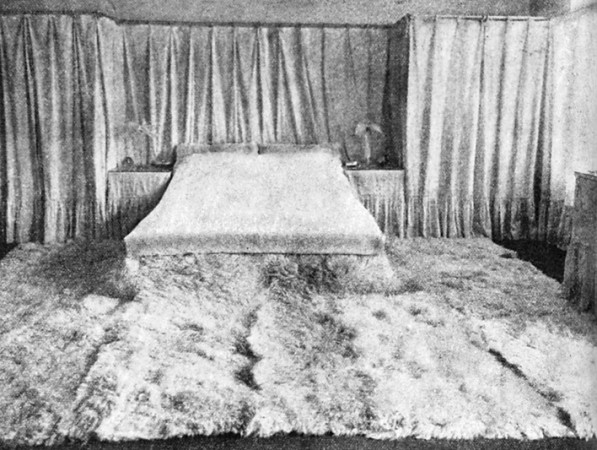
Adolf Loos, 'Schlafzimmer meiner Frau: Weisse Tünche, weisse Vorhänge, weisse Angorafelle', 1903. Photographer unknown.
My favorite example of this is an anonymous photo that was taken in 1903 of the room that Adolf Loos designed for his new wife Lena in the apartment that he completely renovated before they were married. The photo, which can only be found in low quality in an Art periodical from Vienna of that year, is titled: “Schlafzimmer meiner Frau: Weisse Tünche, weisse Vorhänge, weisse Angorafelle.” It shows a room completely devoid of furniture or decoration, covered in white materials.
Most strikingly, an angora carpet covers the floor of the room and culminates between the beds two mattresses. The room is a great example of how avoidance of decoration can create atmospheric effects that parallel those of Jorn’s “spontaneous arabesque”, in a sort of identification with and empathy towards a constructed space. This space is intended to precisely reflect an inner, organic experience just as “spontaneous arabesque” emerges from an attunement to nature, or from “life’s intrinsic patterns” as Jorn deems.
While I understand Jorn’s resistance to the functionalist’s agenda of counter ornamental purification, I can also conclude that at the time his essay was written (1948), many examples of its functionalism can be viewed as decorative today. Looking at this image more than six decades later, it could strike us as decorative, as sort of an adaptation of spontaneous arabesque, because of subtle details such as the sweetness of old fonts, or even the nostalgia they deliver.
My point is that where Jorn leaves us in 1948, functionalism evolves into several styles (Postwar practicalism, Scandinavian minimalism with a focus on natural materials, and then the bright colourful explosion of Italian functionalism. I believe, alternatively, that in it’s most basic sense, functionalism provided us with a perfect shell to be slowly filled with the abounding consumerism, mass media and an overwhelming amount of ornamentation which has been appropriated, sampled and referenced from original sources and for the most part, emptied out of its original contents.
The caption Jorn provides reads: “THE DYING SCREAM OF FACADE ORNAMENTATION. Marketing – it says on the flag blowing in the breeze above this monstrosity of steel, cement, and neon lights. Functional Ice. – This is how far we have gone with our ‘rational’ exploitation of the facade. This is how low we have sunk in terms of artistic culture.”
In a contemporary context, there are a few examples of the power of focusing on inanimate objects, displays and ornaments, where they are given agency that doesn’t bring us as viewers to the returned innocence of “spontaneous arabesque”. It rather brings us to a more contemporary version of materialism which balances the cosmology of spontaneous arabesque with an ironic distance or skepticism of consumerism. The examples I would like to briefly outline are in Shana Moulton’s videos, in David Lynch’s TV series ‘Twin Peaks’ and in a few brief examples of the films of Douglas Sirk. I would like to title these examples:
The Psychology of Hoarding Spontaneous Arabesques
In Shana Moulton’s videos, the character of Cynthia surrounds herself with knick knacks in a domestic setting that range from the holy artifacts to the most mundane thrift store finds. The passage of time has almost equalised the auras and symbolic values of these references. For example, in ‘Whispering Pines #4′ Cynthia’s setting features a copy of Mondrian’s evolution tryptic, which in this setting, hanging over a banal eighties leather sofa, looks like decoration for a medical office.
Cynthia herself, wears a housedress normally worn by women over 65 who can be found in the deepest, darkest realms of domesticity. Cynthia’s housedress however, matches her to Mondrian’s channelling and enlightened figures. This non-hierarchal choreography forms a world where Cynthia can attempt to balance the overempathic activity of her senses. This balance ruptures into ecstatic moments when she emphathises with what we could call the “spontaneous arabesque” of certain materials or objects.
In the contemporary mix-mash of powerful symbols mixed with emptied out consumerism, Cynthia even subverts the functionality of prosthetic devices and wellness knick knacks. She uses them as raw material to build objects which emulate the earnest origins of „spontaneous arabesque“, such as a ceremonial staff she builds from massage tools and brings to ‘The Antiques Roadshow’ in ‘Whispering Pines #4′.
Other mundane objects are used in rituals that seem to balance Cynthia or lend her healing powers. In another video, ‘Sand Saga’, decorative sand, an ingredient bought in craft stores mostly to make simple candles or pour in layers into a glass is diverted by Cynthia’s higher power creature. The creature makes a sandpainting of a reproduction of a navajo blanket, that Cynthia lies on and receives a healing session, where her higher self uses a pseudo-modernist knick knack to cleans her chakras.
There is perhaps a critique here: everything references the earnest roots of indigenous healing, but symbols and ceremonies are improvised and misguided through the outsourced nature of Cynthia’s objects. She doesn’t quite understand her surroundings that she so deeply identifies with, referring back to Jorn’s idea that “(…) the materialist acknowledges that as a human being he is part of the materials and substances and can not be separated from nature (…)”.
I am lead to what one can read as Cynthia’s existentialism; her inability to separate herself from her surroundings due to her vast reserves of empathy that she seems to recharge herself with when she connects to them. In ‘Whispering Pines #9′, this culminates in her mistaking her Avon Foot bath with a valuable Zuni Vase and even making a trip to the Antiques Roadshow herself. In the end, she takes solace in the object’s absurd healing functionality and literally regenerates herself with a footbath.
When getting to know Cynthia, Moulton’s portrayal of her inability to separate from, or to use the objects of a mise-en-scene as catalysts of affect, can be linked to two references: David Lynch’s ‘Twin Peaks’ and the films of Douglas Sirk.
In relation to Jorn’s ideas of not separating with nature and “spontaneous arabesque” (and a materialist identification with nature), it is almost as if the contemporary impossibility of being “natural” becomes a point of stress or trauma. The quirkiness of ‘Twin Peaks’ is also, like Cynthia’s world, initiated by characters who over-emphathize with inanimate objects (such as the lady of the log), or painstakingly hyper decorated sets which have the opposite effect of Cynthia’s surroundings, as they communicate a subtle doom, but this doom seems to correlate to Cynthia’s new age sensibility. In points of crisis, the activation of setting and ornaments that inhabit it are activated to show this dark imbalance. For example, in ‘Twin Peaks’, episode 14, a brilliant long pan is used to show the suffocating atmosphere of the knick knacks and ornaments of the Palmer Family’s living room which culminates in the murdered Laura Palmer’s cousin Maddy (played by the same actress who wears a brunette wig) announcing her need to leave Twin Peaks.
Later in the episode we return to the living room, where Mrs. Palmer has been drugged by Mr. Palmer (possessed by Killer Bob). The living room becomes a platform for the invocation of the Pale Horse.
The following scene has Maddy murdered in the same living room. The final blow is delivered when she is thrown headfirst into the pastoral painting that the living room scene begins with. Here is Mrs. Palmer, the quintessential existential housewife, trapped in her domestic reality, like Cynthia, but without any new age healing mechanisms.
Like Cynthia, the characters in ‘Twin Peaks’ almost psychically bond with their synthetic environments and artifice evokes empathy. A post-Jorn reading of this, could connect the environment of Twin Peaks, and of Cynthia’s interior contructions, as attempts to balance multitudes of reference, to create a sort of universe where the unbalanced patterns of nature are renegotiated.
Perhaps one of the greatest figures who activated the sensibility of “unnaturalness” is the filmmaker Douglas Sirk, whose films were made not long after Jorn’s text was written. Here the film theorist Tom Ryan writes about Sirk’s use of set:
“Most compellingly of all, forces of repression are signalled through Sirk’s imagery. In his work, mise en scène is as crucial to meaning as narrative form, his often baroque visual style pointing to the ways in which human aspiration is largely determined by the tenor of its surroundings. Homes that are supposed to be havens start to look like prisons as the decor comes to dominate the compositions. Objects that are supposed to be items of support actually seem to be taking over the characters’ lives. Their traumas become the logical extensions of the workings of the world around them.” See also http://filmstudiesforfree.blogspot.nl/2010/09/in-authenticity-douglas-sirk-and.html
In Sirk’s film ‘All that Heaven Allows’ a rich widow (also wearing an existential housedress) tells her spoiled, materialist children that she plans to marry her bohemian gardener.
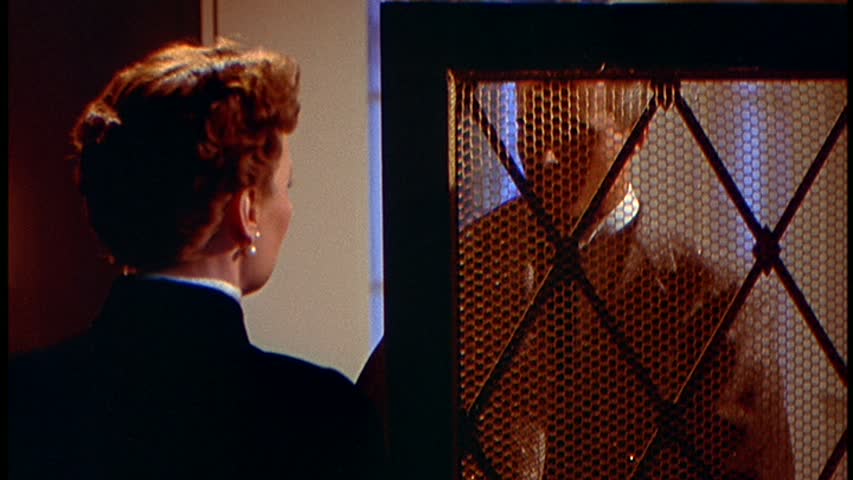
Douglas Sirk, ´All that Heaven Allows´, still. A paravent dividing mother and son resembles a prison.
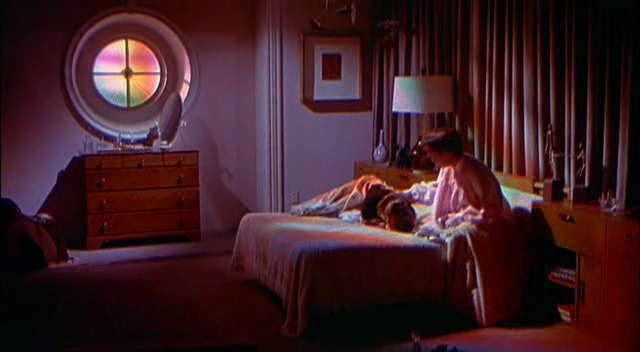
Douglas Sirk, 'All that Heaven Allows', still. The daughter’s bedroom, features a pre-new age window that channels light into a prism. But instead of providing healing properties, the prism’s colourful lights are projected onto the characters and illuminate their misery in a colorful rainbow.
Like Cynthia’s charged settings, Sirk invokes the power of decoration from the point of view of imbalance, of the impossibility of an authentic “materialist” reality, but how aspects of “spontaneous arabesque” can be channeled into novel catalysts of affect.
Shannon Bool
THE GRAMMAR OF SUBSTANCE (I)
Within the framework of my research into Asger Jorn´s writing and thinking I organize public sessions with special guests at a variety of venues. The guest´s practice, knowledge, insights, or responses are informative to my research, or steer the direction I take on a particular topic. The sessions also often respond to the context of the hosting institution, or to a specific request. Making the sessions public is a way to share and enter into a dialogue with the audiences.
‘The Grammar of Substance’ was a talk by Canadian artist Shannon Bool (lives and works in Berlin) and myself in the framework of the exhibition ‘Shana Moulton – episodes from Whispering Pines’ at Nieuwe Vide, Haarlem. The talk took place on Sunday 16 March 2014.
Shana Moulton is an American performance and video artist who lives and works in New York. Her work is very adequately described by Marco Antonini: “Shana Moulton’s videos and performances are in many respects the product of her own fears and anxieties. Surrounded by hysterically colourful and studiedly kitsch scenarios, her filmic alter ego, Cynthia, is obsessed with her health and well-being. In Shana/Cynthia’s hands, inoffensive and awkward medical and orthopedic devices are transformed into surrealistic machines and gateways to parallel realities that are directly linked to her perceived psychological and physical illnesses. Her adventures mirror the insecurities of whole generations while also exploiting stylistic forms and tropes excavated from the recent history of mass-mediated culture.” http://www.museomagazine.com/SHANA-MOULTON In my talk I connected Asger Jorn’s universal ornamental language, or his ideas on ornamentation, to Moulton’s the symbolic and cosmological references. Shannon Bool’s contribution is discussed on this blog in the post ‘The Grammar of Substance II’.
What is an ornament?
The irrational, magic, the attribution of value and value creation, media critique and ornament and decoration are all aspects in Moulton’s work, and some of Jorn’s favourite subjects, so I decided to discuss Moulton’s work through the lens of Asger Jorn’s text ‘What is an ornament?’ from 1948. Throughout the text run a couple of recurring concerns in Jorn’s (earlier) writings: a critique on functionalist architecture, a critique on capitalism and prefabrication, his belief in the interconnectness between things (which leads to the necessity for what he called ‘a living art’), and his firm belief in the capacity of the artist to create the best possible environment for mankind.
The first paragraph of ‘What is an ornament?’ is called ‘On the life and movement occurring in all substances’. It starts out stating that “Matter consists of substances in motion that have different composition values and consistencies. At the interface between two substances engaged in mutual motion, we find the catalyst for that which we describe as the wave formation of matter.” Jorn importantly adds that “There is a cohesion that exists within the reaction forms inherent in different substances and this includes that of mankind.”(Please note that in this blog entry all English citations from ‘What is an ornament?’ come from Fraternité Avant Tout– Asger Jorn’s writings on art and architecture, 1938-1958, ed. Ruth Baumeister, 010 Publishers, Rotterdam, 2011).
Furthermore, Jorn addresses various aspects of the ornament:
The first point Jorn makes is that ornamentation is the geometry of life (of matter) itself. He then explains the difference between a naturalist and a materialist way of working, eventually stating that for the material artist, nothing (not even thought processes) can be immaterial in the deepest sense of this word. I will go into these issues and their implications later on. He also discusses what he calls “the tragic history of the ornament in art”, asserting that there are two different interpretations of the ornament in art:
- The ornament as monumental decoration which seeks to form a finite whole, and becomes static ornamentation. Examples are: classicist Renaissance art, and various forms of neo classicism.
- The ornament as spontaneous arabesque, which manifests itself as a set of elements within a greater whole. This is ‘moving’ and hence dynamic ornamentation. It is about organic cohesion. To be found in the art forms of all primitive people, art of the Orient, prehistoric until Romanesque monumentalism set in. From that moment on there has been a constant reappearance and disappearance of dynamic ornamentation (Baroque, Rococo, Empire, Art Nouveau. (Jorn: Static forms have a tendency to become dynamic because dynamic art is the natural way of things)
Jorn then points at the fact that art itself (in the western world) became split into two categories – the higher, or classical art and folk/banal or spontaneous art. He connects the appearance and disappearance of static and dynamic ornamentation to economic and political changes. This basic point, that the way we deal with ornamentation is influenced by economic and political factors seems to be wholeheartedly confirmed by various contemporary scholars, including Professor Jörg H. Gleiter, who is specialized in the history of the ornament. In ‘Ornament: The Battleground of Theory’ he writes: “Every time the question of ornament arises, it indicates a fundamental structural change which is therefore seen as a crisis and a major upheaval in culture. It is precisely in times of radical cultural change that the question of ornament resurfaces, such as for example at the beginning the 20th century with the transition from production by hand to production by machine, or in the second half of the 20th century with the transition to the structural and post-structural processes of postmodernism. Today too, on the cusp of the change from the mechanical to the digital age, the talk is of the “revival of ornament”. Gleiter’s text can be downloaded here: ”https://www.academia.edu/357179/Ornament_The_Battleground_of_Theory
I would like to return now to the first point that Jorn makes in his text: ornamentation is the geometry of life (of matter) itself, it is “the grammar of substance”. The examination and negotiation of the relation between the materiality of the art work and its discursive meanings, between matter and mind in general, were a central concern throughout Jorn’s practice. The first paragraph of Jorn’s ‘What is an ornament?’ starts out stating that “Matter consists of substances in motion that have different composition values and consistencies. At the interface between two substances engaged in mutual motion, we find the catalyst for that which we describe as the wave formation of matter.” Think of the patterns that the wind creates in the clouds, or in the sand, or the way that sound and light interact etc. Jorn importantly adds that “this cohesion that exists within the reaction forms inherent in different substances, includes that of mankind.”
Jorn illustrates his ideas with several images, including the one below for which he provides a long caption saying: “An ornament? No, a drawing of the orbital paths of a radium atom. Within the most basic elements of matter, ornamentation exists as an objective reality and facilitates mankind’s subjective appreciation of all forms of ornamentation, which is nothing less than the grammar of substance; the geometry of life itself.”
The examination and negotiation of the relation between the materiality of the art work and its discursive meanings, between matter and mind in general, were a central concern throughout Jorn’s practice. The first paragraph of Jorn’s ‘What is an ornament?’ starts out stating that “Matter consists of substances in motion that have different composition values and consistencies. At the interface between two substances engaged in mutual motion, we find the catalyst for that which we describe as the wave formation of matter.” Think of the patterns that the wind creates in the clouds, or in the sand, or the way that sound and light interact etc. Jorn importantly adds that ‘this cohesion that exists within the reaction forms inherent in different substances, includes that of mankind.’
On another page Jorn combines a representation of the earth’s rotational curves, a cross section of the human muscle, the map of a Mediaeval town and ‘Australian sand decoration’.
His caption with the first image is:“A Flower? No, a representation of the earth’s rotational curves within its phases of movement. In every aspect of matter from the smallest atom to the whole universe, we find the same pattern of movements as those created, not just flowers but mankind itself. Everything is reflected within everything else.”
Jorn’s remarks about the interconnectedness of things and humans, of matter in general, about how “everything is reflected in everything else” made me think of some of the images from Shana Moulton’s ‘Whispering Pines 4′, where her alter ego Cynthia goes to see a spiritual healer for her hands and gets sound medication.
Her head shells produce a warm male voice and while listening I caught phrases such as “my true and dynamic nature” , “perpetually transcending” “I’m intimately connected to everything” “”I am more than my physical body. I am limitless.” The cure seems to work, and we soon see Cynthia in various scenarios that literally visualize the words of the healing voice:
The Golden Spiral (which Moulton refers to in the video) represents two well-known shapes in sacred geometry: the golden mean or golden ratio (phi) spiral and the Fibonacci spiral. The unique thing about Phi is that it seems to be a geometrical blueprint for life itself and can be found incorporated in all known organic structures; from the bone structure of human beings to the seed pattern of a sunflower. (think again of Jorn: everything is reflected in everything else)
Materialisms
Let us for now return to Jorn’s theory of materiality, which is inspired by thinkers such as Karl Marx, Susanne Langer, Gaston Bachelard, and the physicist Niels Bohr – all of whom emphasized – in different ways – the role of physical matter in human thinking. In ´What is an ornament?´ Jorn states (as always, from the perspective of artistic practice) that “the materialist acknowledges that as a human being he is part of the materials and substances, can not be separated from nature.” For the materialist artist, Jorn says, human thought processes are instigated by the substances themselves, and are synonymous with the reaction form which these substances have, because thought (which in itself is immaterial in nature) cannot avoid the natural laws pertaining to matter. For the material artist, nothing (not even thought processes) can be immaterial in the deepest sense of this word.
I would like to relate these thoughts to the interaction between ‘Whispering Pines Cynthia’, and the objects from the health industry, the overlooked marginalia, and the poor thrift store objects that she surrounds herself with.
In the majority of the ‘Whispering Pines’ works, to Cynthia’s surprise many of the objects turn out to possess totemic power, agency lies in the objects, and their properties and associations acquire the power to shape the narrative. And even though the results are never what Cynthia or the viewer might expect, the objects’ magic sometimes even turn out to possess healing powers.
To Asger Jorn, and other members of the international Cobra group (1948-1951) which he helped establish, the idea to look at the world and depict it through a child’s perspective as it were, was of great importance. In the case of Jorn it was a decision informed by a desire for (social) change. I wondered in what way this also could apply to Shana Moulton. In the light of this it was interesting to read that in one online interview, Shana said her tutors at De Ateliers in Amsterdam were very critical of her work, and asked her if she was trying to make children’s television. Perhaps they were referring to Shana’s use of the idea of totemic power in objects, to her depicting a world of animate things rather than passive objects?
Contemporary philosopher Jane Bennett however, in her publication “Vibrant Matter – a political ecology of things”, actually tries to actively remind us of the capacity we had as a child to think of things animate. Bennett stresses the urgency to rethink “the idea of matter as passive stuff, as raw, brute, or inert”, and claims that it is time “to acknowledge that the world isn’t divided into dull matter (it, things) and vibrant life (us, beings). The quarantines of matter and life encourage us to ignore the vitality of matter and the lively powers of material formations, such as the way omega-3 fatty acids can alter human moods or the way our trash is not “away” in landfills but generating lively streams of chemicals and volatile winds of methane as we speak.” She argues that politics needs to be ‘ecological’, not in the classical sense of that term (i.e. focused on stable interdependencies between species) but in a more ‘vitalist’ sense that de-privileges humans. “By ‘vitality’”, she explains she means, “the capacity of things – edibles, commodities, storms, metals – not only to impede or block the will and designs of humans, but also to act as quasi-agents or forces with trajectories, propensities, or tendencies of their own.”
It is exactly this “vitality of matter” that Shana Moulton is emphasizing in an artistic and humorous way in her work, and which also seems of crucial importance in Jorn’s words, and Jorn’s works – both in terms of subject, and in terms of dealing with the material.
Based on ‘What is an ornament?’ and other texts by Jorn, I would conclude that according to him, the material world cannot be seen as passive, pre-shaped objects waiting for active subjects to observe and describe. It has its own agency and is constituted partly by its own force and partly by the way we perceive it.
Holism/New Age
I find it important to stress that with the parallels that I draw between Jorn and Shana Moulton’s work (who is obviously flirting with New Age) I have no intention to communicate that Jorn’s notions on interconnectedness have anything to do with holism. Philosopher Tim Morton critiques holism for “being ironically opposed to a truly profound ecological view”. He says: “The reason is simple: when you start to think about how according to holism the whole is always greater than the sum of its parts. This means that at some level there is already fragmentation. It also means that the parts are ultimately replaceable. This gives rise to all kinds of ethical consequences, for instance the idea that it doesn’t matter much to Planet Earth if humans become extinct, or even the idea that humans are a kind of virus—a whole could have faulty components that might need to be cleansed or replaced.” http://philosophyinatimeoferror.com/2010/05/10/tim-morton-the-interview/Morton’s critique explains why I felt a great need to come to terms with Shana’s tongue-in-cheek flirtations with New Age, during the preparations for the talk at Nieuwe Vide, as I have no intentions to create the impression of Jorn as ‘New Age avant la lettre’!.
However, New Age takes a special place in Californian culture. To refer to a quote that Shana Moulton send me from the publication The Alchemy of Trash by Erik Davis: “(…) spirituality, for us (Californians) anyway, takes place in the midst of the market and its commodified fantasies. This feedback loop is especially true in California, where esoteric spirituality has long been a part of a feverish and mercantile popular culture rife with trash. What religious seeking and California culture share most essentially is an investment in fantasy — fantasy not simply as “illusion,” but as the forms that fuse imagination and desire. As both ironic and populist fans of low-brow culture can attest, the ferocity of fantasy can lend a delirious dreamlike power to corny things like UFO cults and commercial entertainments like B-movies or comic books.”
It is in this culture that Shana’s work needs to be contextualized, in relation to which, as she also explains herself in our conversations “her goal has been to ride some line between absurdity and sincerity.” I would conclude that – the core question apparently being whether the whole is a sum of parts, or an undividable whole – Shana eventually seems to undermine the ‘holistic’ perspective of New Age. As Cynthia always seems surprised about the ‘totemic’ power of the objects, doesn’t seem to have any control over the totemic actions taking place, the ‘vibrancy’ of the objects, to speak with Jane Bennett, seems intrinsic, and not added to the existing object. This is a crucial thought for Bennett, which indicates that the whole is not the sum of parts, but that everything is already there.
Also, Shana’s aesthetics flirt with New Age, but her very rudimentary video technique, quick solutions and spontaneous-looking editing process, undermine and contrast with the New Age ‘all-is-beautiful and harmonic aesthetics’ at the same time. Here, we see no harmonious synthesis, but a disjunctive one, that makes it impossible to complete immerse in the spirit of New Age. Let me conclude by observing that Asger Jorn’s attitude is probably best characterized as ironic, humorous, playful, and self-contradictory and that luckily, Shana Moulton’s ornamented universe seems to have come into existence with a similar attitude.
L’ARCHITECTURE SAUVAGE – ASGER JORN’S CRITIQUE AND CONCEPT OF ARCHITECTURE
Within the framework of my research into Asger Jorn´s writing and thinking I organize public sessions with special guests at a variety of venues. The guest´s practice, knowledge, insights, or responses are informative to my research, or steer the direction I take on a particular topic. The sessions also often respond to the context of the hosting institution, or to a specific request. Making the sessions public is a way to share and enter into a dialogue with the audiences.
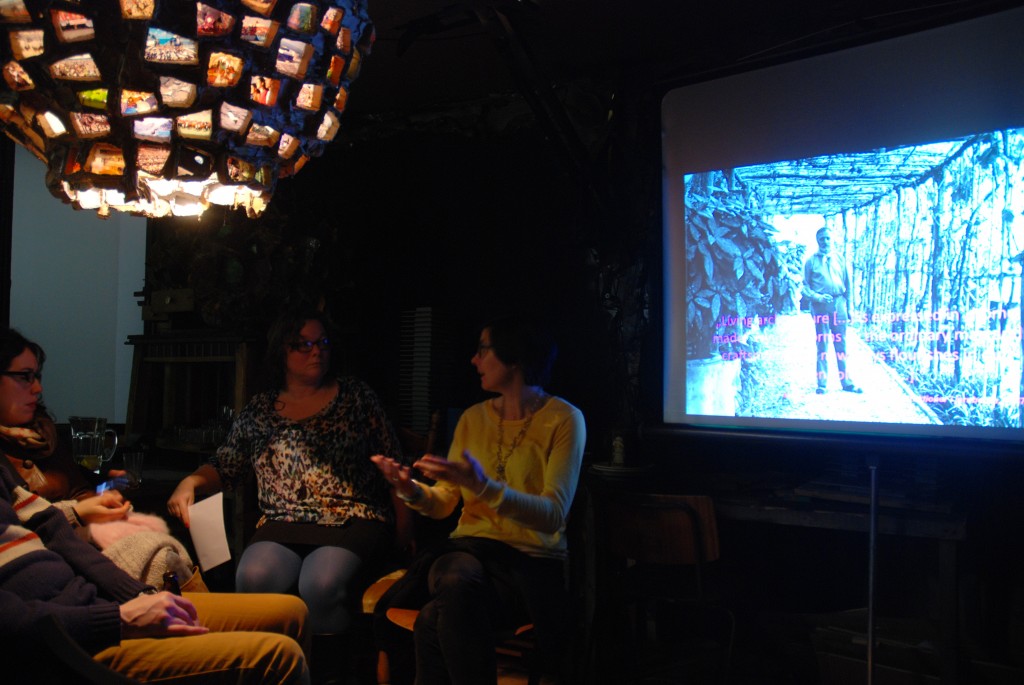
Ruth Baumeister giving a talk inside Rob Voerman’s installation ‘The Fifth Season’, Upstream Gallery Amsterdam, 2014.
L’ architecture sauvage was a talk and interview with Silkeborg-based researcher, critic and teacher Ruth Baumeister at Upstream Gallery, Amsterdam. This session took place Saturday 22 February 2014.
Rob Voerman’s architectural installation ‘The Fifth Season’ conceptually and physically framed the event. As an artist, for the past few years Rob has been creating large-scale installations that are accessible to visitors. The Fifth Season has an additional layer or function, which is to bring people together for meetings, talks, and dinners revolving around the central question of how art and engagement can co-exist. One source of inspiration for Rob´s installation were the ideals of the Bauhaus School. Architect Mies van der Rohe worked within Bauhaus (last director 1930-1933) before moving to the United States in 1937. Here, he designed various iconic buildings that art historically speaking are considered the basis for modern day skyscrapers. Despite the fact that Bauhaus was known for its ideological and socialist character, the buildings Van der Rohe designed were mostly expensive hotels for the upper class. ´The Fifth Season´ is particularly inspired by Van der Rohe’s Seagram building in New York dating from 1958. The Seagram Building is one of the best known buildings by Van der Rohe and right from the start it housed the elitist Four Seasons restaurant. In the 1950s artist Mark Rothko was commissioned to create a series of paintings for the restaurant. The story goes that that Rothko accepted the commission but without telling anyone decided to create “something that will ruin the appetite of every son-of-a-bitch who ever eats in that room.” (Wikipedia) By the time the works were installed however, Rothko decided that the works would “be nothing more than a decorative element in a space where the rich enjoyed their overpriced dinners”, and took the paintings back.
In respect to Asger Jorn, the vocabulary that Voerman has been using to talk about the ‘Fifth Season’ bears some striking resemblances. Voerman speaks about his installation in terms of “a living installation” in which people can sleep, eat, work and meet – Jorn spoke of “a living art”. Voerman speaks of “the complexity of the interconnectedness of systems” in relation to the fact that worldwide problems are so big and complex that we seem to be passed the possibility to change things, as also scientist, environmentalist and futurist James Lovelock claims, whereas Jorn throughout his life worked on the development of no less then “a complete revision of the existing philosophical system” from the perspective of an artist, building on ideas from different fields ranging from physics, mathematics, economics, anthropology, history etc.
In short: a very suitable setting for Baumeister’s talk, which she had structured around four citations from Asger Jorn:
“Functionalism is a construct designed by those without desires – that is, for dead people.” (‘Menneskeboliger eller tankekonstruktioner i jernbeton’, in: Arkitekten, Ugehæfte, Copenhagen, Vol. 49, No. 16/17, 1947)
“Bauhaus is an artistic inspiration, not a doctrine…” (From a letter from Jorn to Max Bill)
“The house must not be a machine to live in, but a machine to shock and capture. A machine of human and universal expression. This is new architecture.” (Letter of Asger Jorn to Enrico Baj, 1953)
“Living architecture […] is expressed in “home-made” housing forms by the ordinary man and craftsman which nowadays flourishes in our garden colonies. […]” (‘Menneskeboliger eller tankekonstruktioner i jernbeton’, in: Arkitekten, Ugehæfte, Copenhagen, Vol. 49, No. 16/17, 1947)
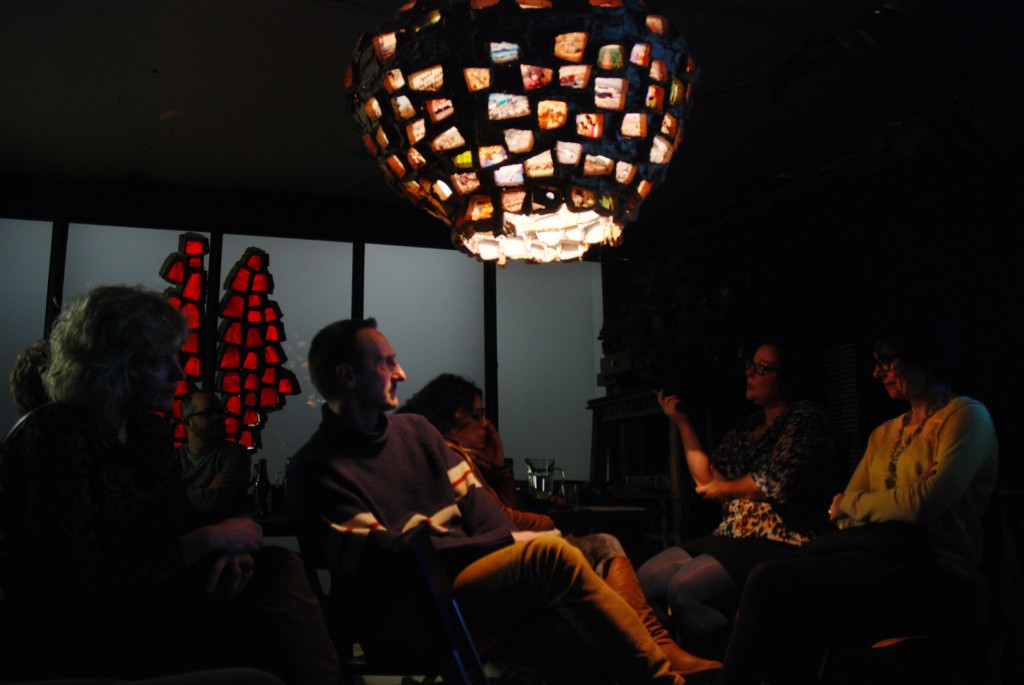
Q&A with Ruth Baumeister inside Rob Voerman’s installation ‘The Fifth Season’, Upstream Gallery Amsterdam, 2014.
Baumeister’s talk was followed by an interview:
HdB: While working on the interview with you on my blog we found out that there are more issues that we would like to address. The session here at Upstream Gallery is a good moment to ask you more about Jorn’s relationship to technology, especially within the discourse of primitivism in architecture. I do know that Jorn has always been interested in science, but I can’t remember reading anything specific about technology as such, or how this would relate to the discourse of primitivism. Could you first say something more about that?
RB: Asger Jorn certainly did not elaborate on technology in architecture as much as he did on the relationship between science and art in his theories, but he does take a clear position. In Pour la forme he states that he is not against functionalism as long as it is for the benefit of people. But if it becomes an end in itself and thus dictates the life of people, then it becomes a problem.
I would argue that he takes the same position when it comes to technology. And even though he criticizes the heroisation of technology by the early century avant-garde, e.g. the futurists, Le Corbusier, Gropius, etc., it does not mean that he is critical of technology in principal. That is also what distinguishes his reception of primitivism from the one by the arts& crafts movement, for example. While Morris and Ruskin reject what technological progress and industrialization has brought about and propagate instead a return to a pre-industrial production and society, Jorn in general accepts developments of industrialization and technology and looks into the future.
If you look at his artistic work, the mural for the Statsgymnasium in Aarhus is a good example for this. You could argue, that he took on the methodological approach of prefabricated industrial production and applied it to a very archaic, if you want “primitive” crafts as ceramics. He created this relief of enormous dimension, by dividing it into over a 1000 singular pieces that he formed, burnt, colored and burnt again in a workshop in Italy and then loaded the whole thing onto a train, shipped it to Aarhus, where it was eventually mounted on site. For the craft production of ceramics, that was very unconventional and certainly technologically advanced.
Thus, the way Jorn created this art piece comes down to his effort to renew an atavistic artistic technique by introducing a new methodological approach. Similar developments you can see in the contemporary digital crafting of ceramic tiles for example.
HdB: One of the other, related issues that we wanted to touch upon is regarding Jorn’s belief that architecture should not be the materialization of a preconceived plan. I think that in relation to this, you wanted to bring up contemporary digital technology as a way to open up new prospects for creating a new architecture, an architecture that can adapt to change (as was one of Jorn’s major demands). Could you tell us more about these developments, and perhaps give some examples?
RB: In his criticism of functionalist architecture, Jorn hit the point of what architects and planners struggle with today, especially when it comes to urban planning. Most often, before a plan materializes, it is outdated and that questions the discipline of planning as such. In his theories, Jorn makes a plea for a living architecture, which he defines as an architecture that is capable of adapting to the ever changing needs of its users. Architecture, as it has been practiced traditionally as well as by the avant-garde of Jorn´s time, works with preconceived ideals, that have a very limited flexibility and are therefore in general not capable to adapt to the ever changing needs of people.
Roberto Matta, for example, whom Jorn met in the late 1930ies in Paris, was originally educated as an architect, worked for Le Corbusier, but finally resigned from architecture and devoted himself entirely to the arts. The reason for this was that he could not identify with any architectural approach and claims, for a living architecture, for spaces, that should be adaptable to human beings. The problem both, Jorn and Matta bring up here is that life is a changing entity while architecture is static. Both Jorn and Matta write in their theories about how to introduce the aspect of time and process.
What would open up new perspectives nowadays for them are the recent developments in parameter planning for example, where the parameters that constitute the planning process can be modified throughout the process. When it comes to your question of primitivism, contemporary development of participatory planning are also interesting, where a good share of what was formerly the work of the architect, especially for the housing sector, is now taken over by other participants, e.g. users, laymen, etc.
HdB: Jorn’s ‘primitivism’ is very much in line with the idea that any human action, institution or custom is at its purest at the moment of inception, and this idea very much informed his thinking about architecture, and its role in society. How do you feel that this stands in relation to Jorn as a highly ethically and politically motivated artist, a position that seems to precede and pervade anything he did as an artist? Would you agree with me, that the rhetoric of ‘spontaneity’ connected to his practice sometimes seems to be at odds with that? Or should I rethink my idea of what spontaneity is when it comes to Jorn?
RB: First of all, I would avoid talking about purism when it comes to Jorn´s ideas in general. What he does is criticizing Western (architectural) culture and in this respect he argues, that every child could do better, because he or she had not been “spoiled” by this what he conceives as indoctrination. I do not see this to be a contradiction to the fact that he is a highly ethically and politically motivated artist, the contrary. In addition to that, I do not see why as an artist you could not be ethically and politically motivated and work spontaneously at the same time? Apart from that, I think his practice is highly complex and differentiated. Depending on which art work you would choose, spontaneity would play a different role. Luckily, especially once he was internationally recognized and sold well, he was frantic about repeating himself and therefore searched for new means of artistic expressions all of his life. This is what makes him so interesting for me as an artist, but, of course, difficult, if you want to pin point him on one specific approach or methodology he uses.
HdB: Jorn was brought up in a very religious family, but stepped out of the religious community at a rather young age to engage with Marxist politics and philosophical questions concerned with explaining the fundamental nature of being and the world that encompasses it, as well as theories from a range of other disciplines. This led him to take on a ‘materialist’ stance, a view on the world that doesn’t seem entirely devoid of spiritual/religious aspects. I’m not sure what terminology to use … Think for instance of the way that he talks about ornamention as the ‘geometry of life’, and as ‘the grammar of substance’, how all matter including human beings are part of one and the same and how the movement of each affects the movements of other(s), or other matter. Would you feel inclined to relate his religious upbringing to his later attitude towards life?
RB: To me, the answer to this is very obvious and therefore rather short. He did refuse his religious upbringing, because of all the restraints that came with it. He did not resent spiritualism, the contrary. If you look at his oeuvre, a lot of his work is very spiritual and the fact that he declared himself to be an atheist, does not mean that religion would not play an important role for him anymore. Especially if you look at the titles of his art works for example, many of them are quotes or recall scenes from the bible. When it comes to the vacuum, that a rejection of God leaves, the “Sinnfrage” it unevitably poses, I think he simply substituted religion with art and he was certainly not the only modernist artist who did so. Just think of Wassily Kandinsky´s book “Über das Geistige in der Kunst”, München, 1912, which was published in many editions and read by a whole generation of artists.
HdB: You also indicated that you would like to refer to Le Corbusier’s famous statement that the house should be a machine for living, in contrast to Jorn’s idea of a house as a machine for expression which is connected to his critique of the modernist paradigm of “Form follows function”. The word ‘expression’ has very strong connotations that have to do with the personal, with authorship …. I know that Jorn had strong opinions about that. I think that I read somewhere that he for instance insisted on the idea that a painter has to sign his paintings. Not as a mark of his genius, but to be transparent about its process of making. How do you perceive Jorn’s use of the term ‘expression’ in relation to notions of authorship?
RB: I never got across the quote that you refer to, but I think it is not so much the authorship as such, that he wants to emphasize, but the subjectivity that lies in art and architecture as a human expression. This is what he wanted to see emphazise and nurtured and a lot of modernist artists and architects strived to eliminate at the same time. In terms of architecture, Jorn pointed at the façade of a building as a surface for expression and a means of communication. It is important to remember here, that he realized the power of architecture in this respect when he worked for Le Corbusier at the 1937 world exhibition in Paris, Le Corbusier´s Pavillon de Temps Nouveaux was explicitly instrumentalized to communicate the political agenda of the Popular Front on the one hand and Le Corbusier’s and Ciam’s agenda for architecture and urbanism on the other. This experience cannot be estimated enough when it comes to Jorn’s understanding and being an artist. As a very young age, he discovered left winged politics for himself and that coincided more or less with his discovery of the arts. For the first time in Paris, at the world exhibition he sees both, politics and arts coming together. Throughout his whole life, Jorn had an agenda – politically, artistically and also personally – and art was a means or maybe even a necessity for him to express it.
HdB: Jorn tried to change the relation between science and art by diminishing the dominant functionalism of science. As you have pointed out also elsewhere on my blog, this has certainly a high relevance for us living in what Guy Debord (1967) called the “Society of the Spectacle”, in which authentic social life has been replaced with its mere representation. In terms of architecture the representation of a building in mass media has become more important than the building itself. You mention however many more issues that Jorn raises which are also connected with the discussion in architecture theory today: identity in architecture and urbanism, architecture as an instrument of social policy, parameter design, to name a few. Could you say more about these connections?
RB: As I have explained earlier, he learned about the power of architecture as a means of expression at the World Exhibition in Paris in 1937. Upon his return to Denmark after this stay, he engages into the debate for a tower for the Arne Jacobsen´s design for the Aarhus City Hall for example. Jacobsen won the competition for the design of a new City Hall, which raised a debate among general public and politicians, who claimed, that this building could be anything, an office building, school, etc. Instead, they claimed a building that they could identified with and demanded a tower, as a sign that is visible in the skyline of the city. Jorn and his friend, the Danish architect Robert Dahlman Olsen, whom he had met during his stay in Paris, took side of the people and in a couple of articles explained the capacity and necessity of a tower as a means to transmit identity.
Regarding the issue of architecture as a means of social policy, I think Jorn, as much as modern architects themselves totally overestimated themselves in this respect. A piece of architecture or urban fabric is a very complex entity and there are many factors, e.g. climate, investment parameters, building law, ect. that determine what it is, not only the idea and/or the will of a single architect.
HdB: Now you have finished your doctoral thesis, I would be curious to know if so far your findings have been consistent with your previous findings on Jorn, or whether you have across anything truly surprising?
RB: Unfortunately, I have to correct you here. I have not finished my doctoral thesis now, but I already finished it in 2009. That means that it took me another 5 years to revise and publish it in English, meaning that I continuously encountered new surprising findings. I came to realize though, that I simply had to stop, because there is no end to a study on Jorn, unless you set it yourself. Right after Architecture Sauvage, Asger Jorn´s Critique and Concept of Architecture went into print by the end of last year, I started another book on Jorn, Asger Jorn, in image, words and forms. It is a general, image based introduction to his oeuvre in English, Danish and German, which will come out at the end of this month and I feel that this is enough now. Time to burry my hero! Who would care about what a 100 year old fellow has to say these days anyhow…?!
HILDE GOES ASGER WITH MATTIN (II)
Within the framework of my research into Asger Jorn´s writing and thinking I organize public sessions with special guests at a variety of venues. The guest´s practice, knowledge, insights, or responses are informative to my research, or steer the direction I take on a particular topic. The sessions also often respond to the context of the hosting institution, or to a specific request. Making the sessions public is a way to share and enter into a dialogue with the audiences.
On Sunday 12 January 2014 a public session at Casco, office for Art, Design and Theory in Utrecht took place including a lecture by me, and an improvised performance by Mattin. http://new.cascoprojects.org/
The lecture I presented is an adaptation of the one for the Athens Biennial. Still largely based on Jorn’s text Value and Economy – Critique of political economy and the exploitation of the unique (1959), I relate some of Jorn’s ideas on the relationship between artist and society to contemporary notions of cultural entrepreneurship within a political situation of “repressive liberalism”, as some sociologists call it. For my lecture I specifically looked at the essay ‘Repressive Liberalism: The Dutch Cultural Policy System’ by sociologist Pascal Gielen (Kunstlicht 1/2, 2013). In his article Gielen seems to suggest that it would be possible to give art a certain independence from conventional ideological idealism (as was Jorn’s stance), and many of his ideas seem tightly connected to Jorn’s notions on value, his concept of art, and the relationship between art and society .
My lecture was followed by a performance by Mattin. He had asked Casco’s director Binna Choi and artist and writer Alexi Kukuljevic to perform the roles of De Jong and Dubuffet using Casco´s material conditions as material for improvisation in an institutional setting. The performance subsequently included the noise of metal foldable chairs stacked onto a pile, me reading out a text from one the book’s in Casco’s library, the sound of a printer and more. Casco at the time, was involved in the collective research ‘(Un)usual Business’ (a research on a new form of economy based on ‘weak’ theory of ‘community economies’) so the text that I was asked to read aloud seamlessly fitted to the lecture that I just held preceding Mattin’ performance. Interestingly enough the topic was similar, but the perspective highly contrasted. Instead of addressing the false rhetorics of freedom in our current ‘market society’, this text was claiming that over the past 30 or 40 decades (in the western world) more resources had been allocated to the arts, and more people had had the opportunity to officially educate themselves as artists.
The set-up by Mattin was aimed to highlight our practices not as acts of freedom of expression in a neutral context but as being embedded within a complex set of interests including economic and symbolic values. The performance created a heightened awareness of both sound and silence, and also created the feeling of uncomfortableness in many people as they were turned into participants, asked to use their own voice and verbalize opinions. This way, the performance gradually shifted from something more abstract and strange to a critical discursive setting. To Mattin “the latter part represented not a moment of agency but instead represented a general paralysis of artistic practices, being able to comment about anything but not finding ways to cut through the determinations imposed by the market.”
HILDE GOES ASGER WITH MATTIN (I)
Within the framework of my research into Asger Jorn´s writing and thinking I organize public sessions with special guests at a variety of venues. The guest´s practice, knowledge, insights, or responses are informative to my research, or steer the direction I take on a particular topic. The sessions also often respond to the context of the hosting institution, or to a specific request. Making the sessions public is a way to share and enter into a dialogue with the audiences.
´Hilde goes Asger with Mattin´ consisted of several activities. Saturday 11 January 2013, the day preceding a performance by Mattin, an artist based in Stockholm, the two of us visited Amsterdam-based artist Jacqueline de Jong. De Jong, a former member of the Situationist International (like Jorn himself) was involved in the musical experiments by Asger Jorn and Jean Dubuffet (1901-1985). Dubuffet, who was invited by Jorn to conduct collaborative experiments at the end of 1960, has written about these experiments in 1961, an English translation of this text can be found on Ubuweb via this link: http://www.ubu.com/sound/dubuffet.html.
Mattin himself works mostly with noise and improvisation. He has also written about improvisation, free software and against the notion of intellectual property (see also his text in the Value and Economy category on this blog). Mattin asked to arrange a meeting with Jacqueline de Jong to talk about Jorn and Dubuffet’s musical experiments. We ended up discussing a variety of topics, but it is De Jong’s account of the musical experiments that sticks with me most.
De Jong told us that at the end of December in 1960, she and Jorn, who loved music and could play the trumpet and violin, took a taxi to a Parisian shop that sold all kinds of western and non-western musical instruments. Jorn approached the shop-owner and asked for as many instruments as possible for the available amount of money. Then Jorn and De Jong went off to Jean Dubuffet, the taxi loaded with instruments that for the most part, neither of them knew how to play. Dubuffet had bought a portable Grundig TK35 tape recorder, and they tried to find all possible ways to create sound with the instruments, while Jacqueline de Jong made vocal contributions (such as screams).
During the conversation it became clear that not only it didn’t matter to Jorn that he had no idea of how to play the instruments, it was what in fact attracted him about it. This way of working, of engaging with the world of matter around him, typifies Jorn. Jorn considered himself a ‘materialist artist’, and I would say that his approach to the instruments is completely in line with this attitude. Similar as in painting or ceramics he would consider a line as “the track a certain substance leaves behind as it passes another substance” (Jorn in ‘What is an ornament?’, 1949), the sound would be the result of his interactions with the materiality of the objects. This unrestrained and experimental approach was of crucial importance to Jorn, who was convinced that it is art’s ability to play and the artist’s inclination to take risks that generates knowledge, change and hence progress.
After our visit to Jacqueline de Jong, Mattin and I went to meet the participants of a semi-public reading session. The participants of the reading session consisted of an intimate circle of people that had shown an interest in Jorn over the past year. Upon Mattin’s suggestion we read the last 20 pages of Jorn’s ‘Value and Economy’, and consequently discussed a variety of topics in relation to our own practices. In hindsight the most striking about the reading session to me is, that Jorn’s outspoken ideas about the position of the artist in society, and especially his willingness as an artist to take responsibility over what he called “the best possible environment for mankind” resonated so strongly. The need for finding ways to take on that responsibility (albeit perhaps not with the pretension to be able to create ‘the best possible environment for mankind’) seems to have regained a certain urgency. This became especially clear when graphic designer Richard Niessen discussed his motivations for starting the ‘Seven Rulers Tracing Board’, a ‘collective’ or ‘platform’ for designers to think through responsible and sustainable design practice. See also http://www.platformbk.nl/2013/12/initiatief-van-de-7-linialen/(text in Dutch)
GO TO HELL BASTARD – Asger Jorn’s construction of his public image
A slightly different version of this text was published in ‘Public Relations’, Rietveld Academy, Art in Context Programme. Amsterdam, May 2014. Eds. Sasa Karalic and Jouke Kleerebezem.
Those who study Jorn get to know him as an energetic and charismatic personality, always on the move and looking for exchange and discussions with others through meetings, the making of collaborative work or magazines, or exhibitions. These discussions were regularly held in public or semi-public realm of conferences and newspapers. Jorn’s output as an artist coincides with a considerable amount of anecdotes and photographs that confirm the impression of him as a playful, spontaneous, and also (thought)provoking and going-against-the-grain type of free spirit that is hard to label or pin down.
When asked to contribute a text to the Art in Context (2014) publication of the Rietveld Academy around the topic of PR, I immediately had to think of how these anecdotes have become inextricably bound to his reception as an artist. It is hard to discuss Jorn and leave these anecdotes out, whereas at the same time there are aspects of Jorn that have been largely ignored in art history, such as the sometimes misogynist tendencies in his writings. As it turned out that Helle Brøns’ PhD research on Asger Jorn includes both a critical questioning of how Jorn himself actively contributed to his public image and gender issues I decided to interview her. Helle Brøns is an art historian who lives and works in Copenhagen working on a PhD on Asger Jorn at the University of Copenhagen, the Statens Museum for Kunst, and Museum Jorn. She is the author of Asger Jorn, Copenhagen 2009; “Masculine Resistance. Expressions and Experiences of Gender in the Work of Asger Jorn”, in October: Asger Jorn: A Special Issue no. 141, 2012 and “The Shock of the Old”, in Hvad Skovsøen gemte. Jorn’s Modifications & Kirkeby’s Overpaintings, Museum Jorn, Silkeborg 2011.
The notion of self-promotion, and the ways that artists actively influence the reception of their work, is a relevant one also in the present time. It is a time in which artists and intellectuals are required to possess of quite a few ‘entrepreneurial’ skills, including networking and self-promotion skills, and dealing with the press. This current call for cultural entrepreneurship has been criticized by sociologist Pascal Gielen as “a misunderstanding”. (Pascal Gielen, ‘Repressive Liberalism – Art, the Art Market and the Cultural Policy System in the Netherlands’ in Kunstlicht 1/2 (34), ‘De Publieke Markt’, 2013) A free translation of his words: “it is in fact a call for self-management, for calculability (yet how can one ‘measure’ the time that is needed to come up with a new idea?) and controllability – the risks of shaping new ideas and objects has to be within acceptable proportions of risk.” Gielen’s critique might be justified, but the ‘entrepreneurial’ aspects of artist hood are an issue usually not ignored by artists that carried to ambition to put a mark on the art and discourse of their time. Asger Jorn definitely belongs to this category of artists.
***
HdB: Risk was an important element in Jorn’s thinking and strategies and certainly not something that he would be willing to shrink to ‘acceptable proportions’ in the ‘entrepreneurial’ sense. I would rather agree with you Helle, that Jorn was “unrelentlessly reckless”. He compared artistic practice with walking on thin ice, and I think that it is in line with this, that he disliked it if people would get a too clear picture of him. He would then undermine that picture, withdraw or do something unexpected so that it was difficult to type cast him as an artist. This does however not mean, that he didn’t like to be acknowledged or recognized as an artist. Chronologically speaking, the very first thing that springs to mind, is the fact that Asger Jorn was born Asger Oluf Jørgensen. He changed his name in 1945, the year that the borders of various European countries opened up again after years of war. In the literature about Jorn his name change is generally interpreted as a way to make it easier for an international network of people to remember him. Would you like to add to that interpretation, and, secondly, do you happen to know if Jorn has ever publicly motivated his name change?
HB: I think the change of name was mostly a question of practicality. Jorn wrote to the Danish artist Robert Jacobsen “Robert, we must have different names. It doesn’t work at all to arrive in France and be called Jørgensen and Jacobsen. Nobody can pronounce it. Damn it, I’m going to find myself another name.” I don’t know of any public motivation, so there is probably no more to it than that. What this does tells us, however, is something about Jorn’s self-confidence. That right after the war he was determined to go out and make himself an international career and that he was very conscious of the importance of having a name in the public. But “Jorn” really isn’t the easiest name to pronounce either, is it? ….. In his local Danish dialect “Jorn” can sound like “Jorden” (the earth) which he might have thought of as a funny connotation. (In Århus in the 1980s someone wanted to name a café after Jorn and were not allowed – they then called it Cafe Jorden as a prank.)
HdB: During the preparatory talk for this interview, we briefly mentioned two photographs of Jorn that we both found striking in the context of the issue of self-presentation and dealing with the relationship with the press. One is a photograph published in the catalogue Expo Jorn – Art is a Festival!, by the Museum Jorn in Silkeborg in 2014. It is a black and white photograph of Jorn, some youngsters and two adults walking up a hill. They are all playing musical instruments. The other example actually concerns a series of photographs of Jorn and art collector Elna Fonnesbech-Sandberg taken for Billedbladet in October 1944. What do you feel is most striking about these photographs?
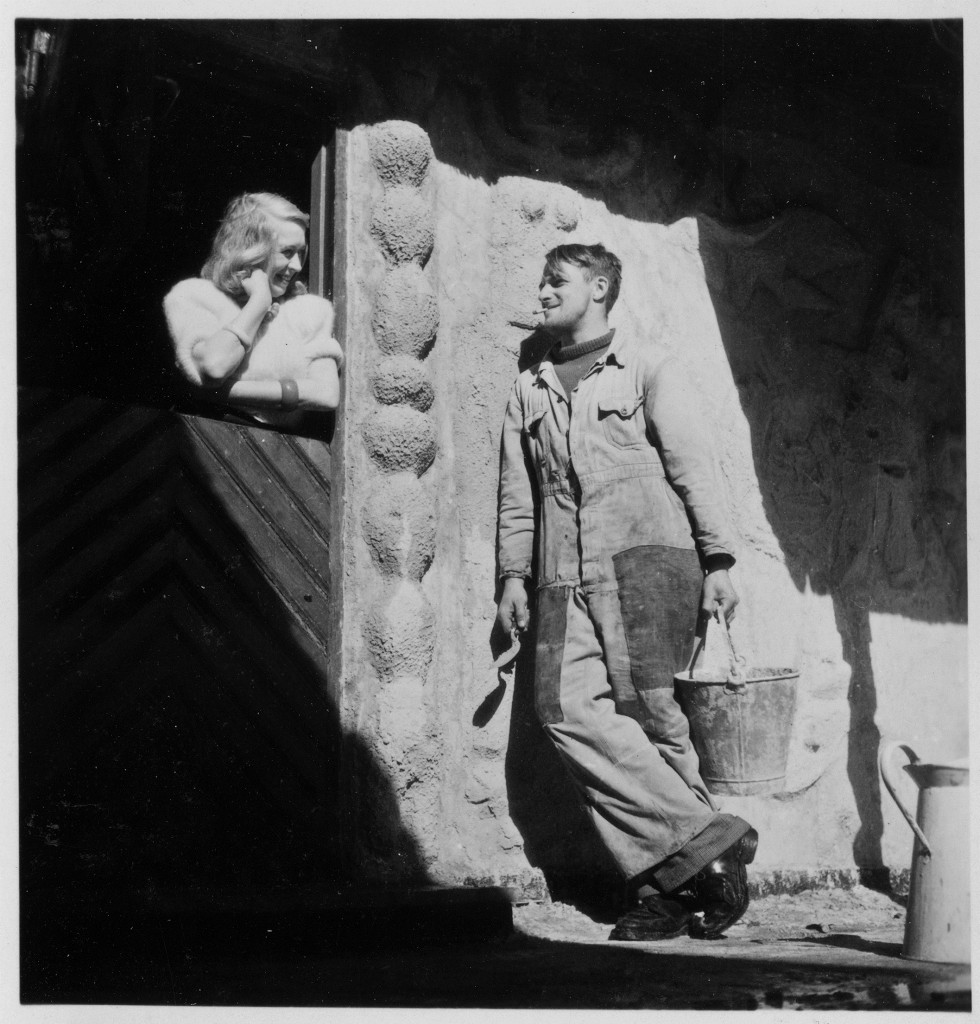
Asger Jorn and Elna Fonnesbech-Sandberg at her Summer house, October 1944. Photography by Olaf Kjelstup for the magazine 'Billedbladet'.
HB: The photographs from Billedbladet are interesting both because they reflect the perception of the artist’s role at the time, and because Jorn so willingly plays the part of the young, bohemian, masculine artist. He is in a boiler suit working outdoors or taking a break while Elna Fonnesbech-Sandberg looks at him in appreciation from inside the house – she is passive, approving and always photographed indoors. The setting is sufficiently domestic and normalized for people to identify with the artist and thereby more easily accept his ‘strange’ modern art. It is a classical setup – which we also know from the photographs of Jackson Pollock and Lee Krasner. Krasner, though being a splendid artist herself, is portrayed as the supportive, admiring wife, while Pollock is performing his drips – which served to anchor the Pollock’s art work in the figure of a white, male (heterosexual) artist. In Jorn’s case however, the woman was not his wife, but his mistress and patron (and future painter and artist colleague). So the rather conventional photographs that seem confirmative of the bourgeois norms and morality in reality covers an even more complex reality. Even if Jorn posed in the public media as a typical artist hero, at the same time he was very critical towards this notion of the genius artist individual, and warned that an artist who lets himself become a celebrated hero will stand in the way of his own art as popular or folk art – which is what he wanted his art to be.
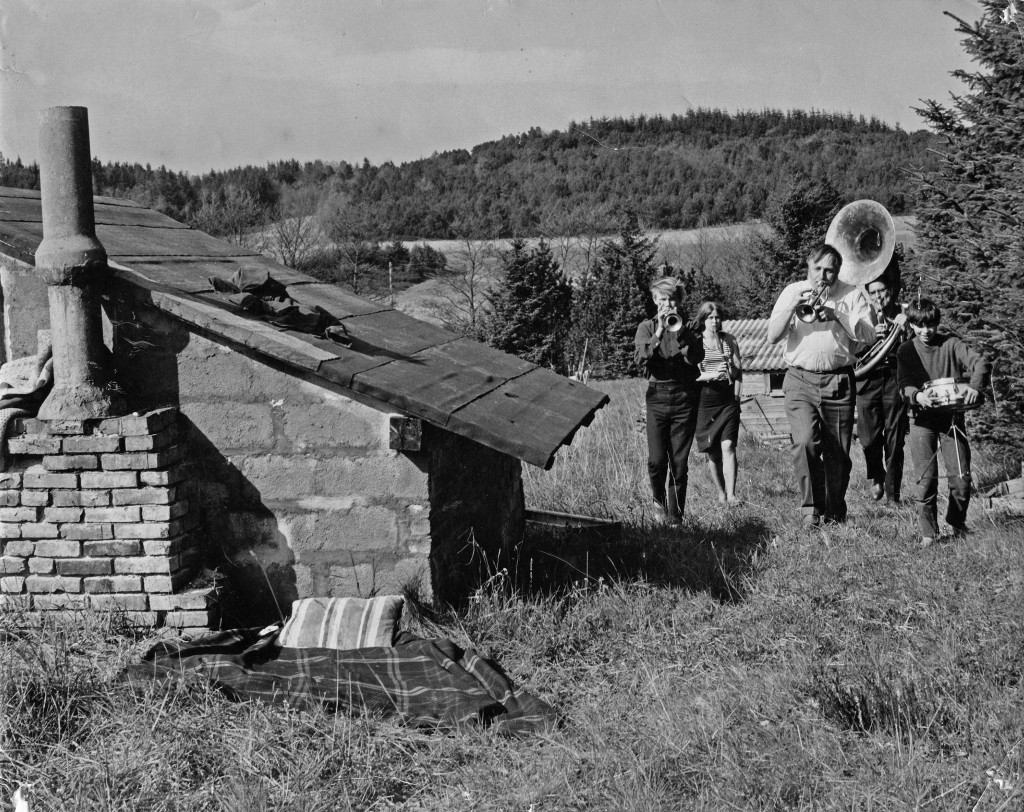
Asger Jorn, Erik Nyholm, Verner Permild and others in a music procession at Erik Nyholm’s place. Photographer and date unknown.
The photo with the music procession was taken at Erik Nyholm’s place (he was a ceramist and a friend of Jorn). He and Verner Permild (a printer) are the other two men the photo. It looks like a happy, spontaneous moment luckily captured on film and it might well have been so. But very often Jorn also initiated such “happenings”, when a camera appeared. He was very good at using such moments to pose as a “bohemian” artist. His son told me that he sometimes put an instrument in everyone’s hands when someone took photographs. When the son objected that he didn’t know how to play it, Jorn said that it didn’t matter – you couldn’t tell from the picture. Again, it shows how conscious Jorn was of how to present himself as a lively, impulsive artist living up to the public expectation, while in reality he was also very strategic and theoretical. I think it might be part of the reason why his theoretical work was not acknowledged as part of his “real” oeuvre for many years.
HdB: The photographs we just discussed show Jorn to be quite strategic with the media, but you told me about a conversation you had with one of Jorn’s children. Apparently Jorn once said that “now he was as good as Picasso was in dealing with journalists”, right after he had answered a journalist from an important newspaper at his front door (who obviously didn’t know what Jorn looked like) that Mr. Asger Jorn wasn’t home, and closed the door. Whereas it is not my intention to try and speculate too much about his motivations for his action (which would suggest that a clear picture could emerge), it seems to me that generally speaking the anecdotes around Jorn generate from more or less spontaneous responses, but that he also knew very well how to use these anecdotes to his advantage or to create a certain image of himself – or if necessary distort that image again. How do you think of Jorn’s ‘strategy’ to always add to complexity and readability of his personality as an artist, his artistic work, in relation to our current times, and to an audience that is already overloaded with information?
HB: I cannot help thinking of the way the British art critic Tom Wolfe in his satirical 1975 book The Painted Word describes the play between the artist and the cultural elite as the “Boho Dance”. An artist can only be successful, he argues, if he knows the rules of this dance: first the bohemian artists performs his moves of utter disdain for the bourgeoisie, at some point the cultural elite will nevertheless make a move towards him and after some discreet hesitation he must accept the accolades and attention.
Wolfe argues that if the artist gets stuck in a crippling disdain for his audience and cannot accept the offer to dance when it is made, he is doomed to stagnation and will not be revered by history. Artists like Picasso excelled at this art mating ritual, he said, while Pollock was the classic case of the artist hopelessly stuck between the Boho Dance and the fulfillment. A few artists however managed to double-track their way from the Boho Dance to the consummation, but truly successful double-tracking requires the artist to be a sincere and committed performer in both roles, he argues. I think this is what Jorn attempts – to be true to his communist belief and at the same time have success without kissing ass. As is typical for him, he tries to change the rules of the dance. Wolfe points out that the general public was not part of this transaction; perhaps one could say that Jorn attempts to move the dance into their territory (by connecting so strongly with folk art and popular art). Particularly in his Situationist period of course he was split between the success of his painting and the anti-capitalist critique of the SI – this split made him invent an alter ego – George Keller – who stayed in the SI while Jorn resigned. He then canalized some of the money earned on painting back into the subversive activities in SI.
I think the Boho-dance is still in function today – think of someone like Damien Hirst – but of course the scene has changed radically. The performance, which was for a very long time acted out on a unisexual scene – was overplayed and can no longer be presented as natural or credible. There are more artist roles available and a much broader cast. Also, many artists today work with the public media as a medium – a strategy that the situationists were some of the first to use – but the attitude of most younger artists towards media, institutions or consumer society is much more workable and diverse. The recognition of artistic research that Jorn struggled for is very relevant today and in some ways obtained, which also allows for different relationships between artist and public.
HdB: During his lifetime Jorn wrote a great deal of texts. He was very outspoken about many topics, and he was a well-read man. in the reception of his texts at the time, and still today, his textual and more philosophical output are primarily considered an example of artistic thinking. In the 1950s however, Jorn send in one of his existing manuscripts at the University of Copenhagen, asking to consider it as a dissertation. The university rejected his application, which as you suggested, could not have come as a big surprise to him. Do you think that he really wanted to position himself as an intellectual, or what else do you think might have been his agenda with this application?
HB: Yes, in 1952, he submitted his aesthetic manifesto Luck and Chance to the University of Copenhagen in order to have it accepted as a philosophical doctoral thesis. The book was rejected because it did not meet the university’s academic requirements, full as it was of intuitive leaps and argument from one discipline used in the field of another. I believe his purpose was to proclaim the existence and value of an artistic way of thinking as an equivalent alternative to the philosophical and scientific one. His theoretical work was both very sincere and at the same time it included a humorous, irrational aspect which was not compatible with academia). Jorn strikes me as an intellectual who does not want to be intellectual. In his introduction to a later book The Natural Order, he stated that success as a philosopher would be “the most embarrassing and ridiculous thing I could ever achieve. It would be like giving a man who loves women the most beautiful wax mannequin in the world, complete with real hair.” What he cared about was the “real thing”, a living, passionate sensuous reflection rather than an elaborate, but lifeless, philosophical thinking. In the same book he claims that “We need a Ministry of Disturbance, a regulated source of annoyance, a destroyer of routine, an underminer of complacency, or, in other words, a ministry of aesthetic activity.” I think Luck and Chance was intended as such a disturbance.
HdB: Jorn was quite critical of the idea of the museum as the arbiter of taste and what could be called the culture industry of his time. When Jorn was awarded the Guggenheim Award in 1964, he send a telegram to the president of the Guggenheim saying:
GO TO HELL BASTARD—STOP—REFUSE PRIZE—STOP—NEVER ASKED FOR IT—STOP—AGAINST ALL DECENCY MIX ARTIST AGAINST HIS WILL IN YOUR PUBLICITY—STOP—I WANT PUBLIC CONFIRMATION NOT TO HAVE PARTICIPATED IN YOUR RIDICULOUS GAME.
On January 8, 1964 he also send a longer letter explaining himself in more detail, stating that he has always refused any price as “pricegiving is the establishment of an hierarchic distinction between artists”, and on top of that he adds that refuses to be used as “an example to artistic and public education, as I hate every sort of education en bloc.” The Danish writer and critic Elsa Gress (1919-1988) however, didn’t necessarily think of Jorn’s action as daring or risk-taking, but pointed out that he might gain more from all the media attention then from the award itself. Could say a little more about what she said, and in what context their subsequent dialogue took place?
HB: I think the rejection of the Guggenheim Price is a perfect example of Jorn’s attempt at double-tracking: a perfect abusive Boho dance move but at the same time he got more publicity without compromising his convictions. What Elsa Gress did was in a way to expose this transaction as part of the game. She discussed how abstract spontaneous art had become academic and that there was too much speculation and publicity in art – even Jorn who just turned down the Guggenheim price uses publicity, she says. Jorn wrote an angry reply, refusing to ever have used publicity besides the publicity implicit in every artistic statement. Gress then pointed out that because of his constant presence in the media, his writing, debating and self-conscious appearance Jorn’s public persona, whether he wanted it to or not, confirmed the image of the artist as a genius bursting with masculine vitality and agency. This artist’s role expressed the last gasp of patriarchy, as she saw it, noting Pollock as an example of a male artist self-destructively living his own myth. This was a sore spot for Jorn, who himself saw modern society as being increasingly influenced by what he defined as female values of harmony and stagnation, while masculine values such as experimentation, aggression and innovation lost territory. In the following discussion they both projected gender differences onto their arguments.
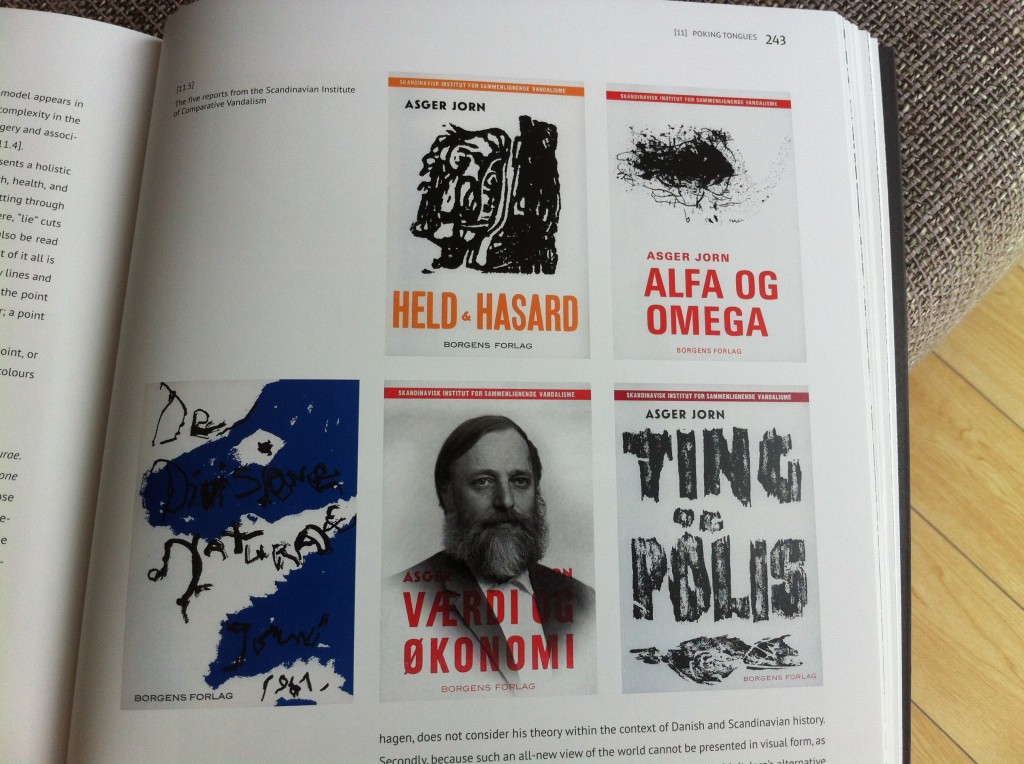
Photograph of a page from 'Asger Jorn - Restless Rebel', Statens Museum for Kunst, Copenhagen 2014. The page includes book covers of books written by Jorn, including 'Value and Economy' which shows Jorn posing as Marx.
Gress – taking off from Simone de Beauvoir, Margaret Mead, and others – was advocating for a general humanism that does not discriminate between the sexes, while Jorn stressed the generic differences between the sexes. In his book Alpha and Omega he continues this discussion of art and gender in rather misogynist terms. He does, however, also have a very humorous and ironic tone, which is also evident in his art – not least the modifications and disfiguration which ridicule both men and women. Such “self-portraits” as the one at the cover of Value and Economy, where he poses as Marx is a similar ironic self-representation: He puts himself as an artist thinker in the place of the philosophical father figure. In another photograph he poses as the little mermaid and ironically shows himself as a paradoxical, popular national symbol with breasts, pipe and beard. I think it is a great picture of his self-ironic attitude to his public image as a masculine artist hero.
The Hidden Persuaders / The Hidden Artist
I would like to conclude this interview with thanking Helle Brøns for her time, energy and insights, and with a photograph that I took at Museum Jorn, in a small room that contains part of Jorn’s personal library. It is a photograph of the title page of the book The Hidden Persuaders by Vance Packard, underneath which Jorn wrote ‘The hidden artist’. It is an interesting note perhaps to end with, as Jorn draws a direct parallel between the artist’s practice and the work of PR managers and other ‘persuaders’.
Packard’s book The Hidden Persuaders was first published in 1957, and according to his underlining of many paragraphs, Jorn must have read it with interest. Packard looks into the use of psychological techniques by advertisers to influence the behavior of potential buyers. Packard identified several “compelling needs” that advertisers promise products will fulfill that according to him are so strong that people are not able to resist the impulse to buy. Packard also looks into the manipulative techniques of promoting politicians to the electorate and questions the morality of using these techniques.
In ‘The Exploitation of the Unique’, the second part of his publication Value and Economy, Jorn discusses the subjective and human passion at length in relation to art, politics and advertisement. He writes for instance: “The best object for exploitation in human society is human desire and enthusiasm and the creative results of this, our cultural past” and “Politics consists of catching people’s attention and is thus art.” (Asger Jorn, “Value and Economy – Critique of Political Economy and The Exploitation of the Unique’ in The Natural Order and other texts, translated by Peter Shield, Ashgate 2002) At the core of his thinking lies the idea that art is the ultimate tool for invoking differences in values, for invoking change and that only changes can catch people’s attention. He then indeed draws a parallel between art and advertisement saying “(…) academics have made a false separation between what they call art and what they call advertisement. They simply refuse to admit the obvious that all art, even that of Beethoven and Rembrandt, is art because, amongst other things, it is an advertisement for something, and that to advertise is to give sensory experience an extraordinary significance. That a sensory experience is given an extraordinary significance is first and foremost to say that that one is conscious of it as something important and something present.” (Value and Economy)
In ‘Value and Economy’ Jorn shows himself critical of the role of mass media in the dependence of politicians’ popularity and he shows himself critical of the role of the advertisement industry in relation to commodity consumption, but perhaps most importantly in the framework of the artistic practice, he shows himself critical of academic thinking about the value of sensory experiences. He says that the consciousness, the focus of attention that artists can generate “is what in the most elementary sense could be called intelligence”.(Value and Economy) Academics, according to Jorn, have refused to acknowledge the intellectual aspect in this process. To Jorn however, intelligence does occupy itself with experiences of reality, not only with concepts. He can’t relate at all to the academic concept of reality as something that cannot be experienced but only comprehended: “Art is to be able, but to be able is also to know” (Value and Economy) says Jorn, which to him means that you can’t remove knowledge from art, or isolate direct knowledge from the problem of intelligence.
It is useful to realize how aware Jorn himself was of the importance of human desire and the focus of attention where it comes to his public image. The image of Jorn as a bohemian artist did not occur as ‘naturally’ or spontaneously as it looks like at first glance, and a critical look at his practice and thinking from the perspective of gender issues also completes our image of him in a different way. At the same time, the numerous photographs of Jorn smoking, of Jorn working with paint, clay or textile, of Jorn eating, drinking, of Jorn flirting, of Jorn playing a musical instrument, but rarely of Jorn not engaging with the world of matter around him, seem to focus our attention not only to him but also to one of the most fundamental ideas underlying his practice, which is that through experimenting, a direct engaging with matter, art invokes differences, and by invoking differences art generates knowledge about ourselves and the world around us. This is not the ‘scientific’ or objective type of knowledge, but a type of knowledge that issues from the subjective, from the needs of mankind. In terms of art, to Jorn this was the true meaning of realism – which when you come to think of it, sheds another light of some of the photographs discussed above. Perhaps Jorn’s ‘manipulations’ were foremost aimed to bring across the image of something as ‘real’ as possible.
PRODUCERS-PARASITES-HOSTS (Athens Mix)
Within the framework of my research into Asger Jorn´s writing and thinking I organize public sessions with special guests at a variety of venues. The guest´s practice, knowledge, insights, or responses are informative to my research, or steer the direction I take on a particular topic. The sessions also often respond to the context of the hosting institution, or to a specific request. Making the sessions public is a way to share and enter into a dialogue with the audiences.

National Bank of Greece Building (former Stock Exchange), Athens, used as the main venue for the Athens Biennial 4 – Agora, 2013.
‘Producers-Parasites-Hosts’ was a collaborative performative lecture with Amsterdam-based artist Annabel Howland and part of “The Non-Serious Lectures” (on economy and value) programme at the Athens Biennial – AGORA 2013. It took place on Thursday 28 November, 2013, in the disused National Bank of Greece Building (the former Stock Exchange), in Athens. Using the building of the former Athens Stock Exchange as its main venue, AB4 proposed AGORA not only as a place of exchange and interaction, but also as an ideal setting for critique. The main focus of this programme was to highlight and discuss the shortcomings of the economy.
I invited Annabel Howland to turn part of her work-in-progress ‘Producers-Parasites-Hosts’ into a 20-minute, multi-channel sound piece with slides, ‘Producers-Parasites-Hosts (Athens Mix)’. The work contains a multitude of voices, including research-scientists-turned-investment-bankers, a leading evolutionary biologist, economists, and an HFT expert, speaking about parasitical and productive relations. Parasites never benefit their hosts. So why would cooperators benefit their hosts at their own expense? And what is the role of ‘cheaters’? Through intricate editing, Howland builds up a speculative web that draws lines between art, finance and science. A documentation version of her sound performance can be found here: http://www.annabelhowland.nl/blog/athens-mix/
Howland’s artistic research into the world of finance and mutually beneficial relationships in biology stimulated me to develop a lecture that looks into Jorn’s ideas on the position of the artist in society. The lecture is to a large extent based on Jorn’s publication ‘Value and Economy – A Critique of Political Economy and The Exploitation of the Unique’, but is also indebted to Graham Birtwistle’s insightful publication ‘Living Art – Asger Jorn’s comprehensive theory of art between Helhesten and Cobra (1946-1949)’. For the lecture in Athens I compiled a somewhat ironic give-and-take chart, between artist and society. When Jorn provides ‘arguments’ that cannot be quantified, or balanced out on a chart, I discard them and proceed with explaining his notion of a ‘living art’. Here is a link to a sound recording http://www.annabelhowland.nl/blog/athens-mix/.
OVERVIEW PUBLIC SESSIONS
In the framework of my research into Asger Jorn´s writing and thinking I organize public sessions with special guests. The guest´s practice, knowledge, insights, or responses are informative to my research, or steer the direction that I take on a particular topic. Oftentimes, the sessions also responded to the context of the hosting institution, or to a specific request. Making the sessions public is a way to share and dialogue with audiences. Below is an overview of the the sessions that took place so far. I also post more detailed reports.
PRODUCERS-PARASITES-HOSTS (ATHENS MIX)
A collaborative performative lecture with Amsterdam-based artist Annabel Howland as part of “The Non-Serious Lectures” (on economy and value) programme of the Athens Biennial – AGORA, 2013. The lecture took place Thursday 28 November 2013, at the deserted National Bank of Greece Building (former Stock Exchange), in Athens.
HILDE GOES ASGER WITH MATTIN
Hilde goes Asger with Mattin consisted of a semi-public reading session, a performance by Stockholm-based (sound) artist Mattin and a lecture by myself at Casco, office for art, theory and Design in Utrecht, NL. The performance and lecture took place Sunday 12 Jan 2014, coinciding with “Utrecht’s Cultural Sunday”, and as part of Casco’s collective research (Un)usual Business on a new form of economy based on “weak” theory of “community economies.”
L’ARCHITECTURE SAUVAGE – ASGER JORN’S CRITIQUE AND CONCEPT OF ARCHITECTURE
A talk and interview with Silkeborg-based researcher, critic and teacher Ruth Baumeister at Upstream Gallery, Amsterdam. This session took place Saturday 22 February 2014. Rob Voerman’s architectural installation ‘The Fifth Season’ conceptually and physically framed the event.
THE GRAMMAR OF SUBSTANCE
A talk by Berlin-based artist Shannon Bool and myself in the framework of the exhibition ‘Shana Moulton – episodes from Whispering Pines’ at Nieuwe Vide, Haarlem, NL. The talks took place on 16 March 2014, coinciding with ‘de Haarlemse Lente’.
THINKING THROUGH MATTER
A talk by Ferdinand Ahm Krag and myself in the framework of the exhibition ‘Asger Jorn – Restless Rebel’ at the Statens Museum for Kunst / National Gallery, Copenhagen. The talks took place Saturday 22 March 2014.
COMPARATIVE VANDALISM
‘Comparative Vandalism’ was an exchange of thoughts on Asger Jorn’s Scandinavian Institute of Comparative Vandalism hosted by Officin Books, Paper and Prints Copenhagen. With Niels Henriksen, Ellef Prestsæter and Nicolas Malevé as special guests and with Søren Andreasen, Helle Brøns, Louise Hold Sidenius, Marie Kølbæk Iversen, Jørgen Michaelsen, and Teresa Østergaard Pedersen. The session took place Sunday 6 July, 2014.
PILLAR HUGGERS
A workshop and an exhibition at Or Gallery, Berlin. With Antonis Pittas, Johann Arens, Jay Tan, Klaus Weber, Christoph Keller, Hilde de Bruijn, Shannon Bool, Hadley+Maxwell. Exhibition dates: January 23 – April 18, 2015
KLARA LIDÉN, PILLAR HUGGER
A lecture by me, discussing the work of Klara Lidén (1979) through the lens of Asger Jorn’s ideas on vandalism. The lecture took place on January 6, 2016.
ASGER JORN: THINKING IN THREES
A session with Athens-based artists Kostis Velonis and Yiannis Isidorou hosted by Circuits and Currents, the Project Space of the Athens School of Fine Art. The session took place on January 8, 2016.
